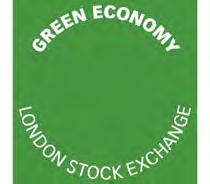DON’T HANG AROUND
5 investment trusts that won’t stay this cheap for long


US BANKS
VOL 25 / ISSUE 15 / 20 APRIL 2023 / £4.49
How the sector is shaping up after recent crisis






• Positive bank reports set S&P 500 on course for new highs
• A slowing US economy and sticky inflation leaves the Fed little choice

• What to expect from Sainsbury’s results after Tesco’s growth warning
• New record high for LVMH as Chinese demand returns
• Why Superdry shares are down almost 50% in one year
13 GREAT IDEAS New: Computacenter / Nippon Active Value
Updates: XP Power
18 FEATURE Don’t hang around: 5 investment trusts that won’t stay this cheap for long

25 SECTOR REPORT Find out why gambling shares have diverged in recent months
30 FEATURE How you can buy the market with less risk than the index
35 FUNDS Fifteen people to decide what goes in a fund portfolio: too many or clever idea?
39 FUNDS Baillie Gifford Positive Change: Can impact investing pay off for investors over time?
42 EDITOR’S VIEW Are European or US oil firms taking the right approach to renewables?
44 PERSONAL FINANCE The little-known rule that could boost grandparents’ state pension

46 RUSS MOULD Do gold stocks have the Midas touch right now?
49 ASK TOM What do I need to think about before accessing tax-free cash from my pension? 52 INDEX Shares, funds, ETFs and investment trusts in this issue


20 April 2023 | SHARES | 03 Contents
06 NEWS
07 30 44
49 18
UKatinvestmenttrustsaretrading thewidestdiscountseen sincethe2007/8financialcrisis, accordingtorecentresearch
DON’THANGAROUND 5investmenttruststhatwon’tstaythischeapforlong
averageweakinvestorsentiment,thesectorweighted discountwidenedfrom2.3%atthestartof2022to16.4%bytheendofMarch2023. tradingForexample,theGlobalsectoriscurrently five-yearona9.27%discounttoNAVversusa 2.87%average,accordingtodatafrom theAIC(AssociationofInvestmentTrusts).Itis worthhighlightingthisinvestmenttrustsector becauseithousessomehugelypopulartrust names,suchasBrunnerInvestmentTrust(BUT)ScottishMortgageInvestmentTrust(SMT) Monks InvestmentTrust(MNKS) AllianceTrust(ATST) andLindsellTrainInvestmentTrust(LTI) Forabriefrecap,whenwetalkaboutadiscount,
Don’t hang around on these investment trusts
ofwearedescribingthegapbetweentheshareprice value.aninvestmenttrustsversusitsNAV,ornetasset Inotherwords,thevalueoftheunderlyingassetsinthetrust’sportfolio. consequence‘Discountsare,atafundamentallevel,aoffewerbuyersthansellers,’says atAlanRay,aninvestmenttrustresearchanalyst pricesKeplerTrustIntelligence.‘Ifyouthinkofshare premium)asapopularitycontest,thenadiscount(or isthe“clearingprice”atwhichbuyersarewillingtostepin.’ duringThereisaninevitabilitythatdiscountswillwiden timesofeconomicandmarketuncertaintyascapitaldriesup,butsuchasteeplevelof candiscountshouldnotlastlong.Thissuggestsvalue partbefoundinthiswell-establishedanddiverse ‘InoftheUKinvestmentindustry. valueourview,thishascreatedsomenotable opportunities,especiallyamongstsectors
Discover five trusts which are trading at larger than average discounts to the value of their assets
theBigWallStreetfirmsmostlyshrugoff turmoilofrecentweeks
TgotheUSfirst-quarterearningsseason April)offtoaflyingstartlastFriday(14 afterbankinggiantJPMorgan (JPM:NYSE)smashedestimatesfor revenueandearnings,helpingliftthewholestock markettowardsnewhighs. billion,Thecompanyreportedrecordrevenueof$38.3 wellaheadofconsensusforecastsof$36.1werebillion,whileearningspershare(EPS)of$4.10 20%abovemarketestimatesand50%higherthanthepreviousyear. weeksConsideringtheupheavalofthefinalthree ofthequarter,withthefailureofSilicon ValleyBank,SignatureBankandCreditSuisse, investorreliefwaspalpablewiththeshares jumping7.5%to$138onthereport. downChiefexecutiveJamieDimonsoughttoplay mood,theideathebigbankswereincelebratory however,sayingwhiletheyhadbenefitted banksfrominflowsthenotionthatthefailureofsmaller wasgoodnewswas‘absurd’.Citigroup(C:NYSE)anWellsFargo(WFC:NYSE) Citialsoreportedbetterthanexpectedresults,with lendinghelpedbythesaleofitsIndia-basedconsumer businessandWellsFargobenefitingfrom highernetinterestincomeduetohigherrates, althoughitwassanguineontheoutlookfor consumerfinances.
500PositivebankreportssetS&P oncoursefornewhighs
Three important things in this week’s magazine 1 2 3
SharesinPaddyPower,BetfairandFanDuel ownerFlutterEntertainment(FLTR) year,havegainedaround80%overthelast handsomelyoutperformingthe FTSE100andUKgamblingpeerswhichhave registeredlosses. RivalEntain(ENT)whichoperatestheLadbrokesandFoxyBingobrandshasseenitsshareslose around15%,while888Holdings(888)sharesaredownaround70%andbingoandcasino operatorRankGroup(RNK)isdown43%over thesameperiod. beenInvestorswillrightlybeaskingwhytherehas suchabigdisparityinperformanceacrossthesector.
custodyItwasn’tallgoodnewsthough,assharesin bankStateStreet(STT:NYSE)slumped9% on17Aprilafterfirst-quarterrevenueandearnings missedanalysts’forecasts. Investorswerealsounnervedbythetrendin

US banks in the spotlight

$20customerdeposits,whichexperiencedoutflowsof leadingbillioninsteadofexpectedinflowsof$8billion, toasharpdropinnetinterestincome. provisionsThemoodwasfurtherdarkenedbyarisein forbadloansanda$29millioncharge Stateforpotentiallossesonthe$1billion‘backstop’ StreetprovidedtoFirstRepublicBank (FRC:NYSE)aspartofits$30billionbailout.WallStreetgiantGoldmanSachs(GS:NYSE) ofpostedamixedupdateon18April,withEPS revenues$8.79easilytoppingforecastsof$8.10butmissingestimatesafterthebanksoldoff achunkofitsloanportfolioasitexitsconsumer incomelending.Analystswerealsosurprisedtoseetrading missestimates,giventhebank’sforte incapitalmarketsandtherelativelystrong performancebycomparisonofrivalssuchas CitigroupandBankofAmerica(BAC:NYSE) withThelatterwasabletorestoresomeconfidence higher-than-expectedfirst-quarterrevenue forandearnings,sendingitssharesup2%pre-market Asagainof8.5%overthreedays. Shareswenttopress,investorsweregearing ofupformorebankingreports,thistimefromsome thesethesmallerregionallenders.Asthechartshows, sectorfellmoresharplyinMarchasthecrisisinthe leftthemlookingvulnerable.[IC]
Divergent fortunes in the sector as reporting season follows recent crisis of confidence
Visit our website for more articles
Did you know that we publish daily news stories on our website as bonus content? These articles do not appear in the magazine so make sure you keep abreast of market activities by visiting our website on a regular basis.
Over the past week we’ve written a variety of news stories online that do not appear in this magazine, including:
Findoutwhygamblingshareshave divergedinrecentmonths
SectorReport:Gamblingstocks
Flutterhasbeenindemandwithinvestorswhile888hasbeenfirmlyleftinthecold
CONTRASTINGFORTUNES toThebroadanswertothequestionisrelated importantlyregulation,bothhereintheUKbutmore acrosstheAtlantic. SportsIn2018theUSPASPA(ProfessionalandAmateur allowedProtectionAct)wasoverturnedwhichsportsbettingtobeconductedinallstates. Fiveyearsontherearemorethan30stateswhich permitsportsbettingalthoughsomeonlyallow in-personbetting.
FlutterKeyfinancialdataforgamblingfirms


Flutterhasestimatedtheopportunitytobe
worthover$40billionofannualgrossgaming inrevenuesinthemediumterm.Fluttertookastake anfantasysportsbettingcompanyFanDuelgivingit outearlyleadinthefledglingmarketbeforebuying Aftermostoftheminorities.toyingwiththeideaoflistingFanDuelin peerstheUStotakeadvantageofhighervaluationsof suchasDraftKings(DKNG:NASDAQ) theofcompanydecidedtooptforasecondarylisting FlutteronNasdaqwhichhasgiventhesharesabigboost. sentiment:Berenbergsumsupcurrentinvestment‘TheUScontinuestobethejewelinthecrownforFlutter.InQ4,itwastheclear number-onesportsbookwitha50%share,while continuingtogainshareiniGaming(gaming conductedelectronically).’
Gambling sector report

What has performed best and worst and the key themes, metrics and catalysts which are driving share prices

Moneysupermarket reaps the benefits of more people shopping around for insurance

04 | SHARES | 20 April 2023 Contents
News 06 SHARES 20April2023
USFederalFundsTargetRate Rebasedto100 Nov 2022 DecJan 2023 Feb MarApr 80 90 100 110 120 S&P500Banks S&P500RegionalBanks Chart:Sharesmagazine Source:Refinitiv
20April2023 | SHARES 25
Entertainment 31.7 39.3 37.4 Entain 10.6 22.1 12.1 888Holdings 2.1 4.9* 6.7 RankGroup 0.5 14.1 N/A Company Enterprisevalue(£bn) Forecastpricetoearningsratio EV/EBITDA *Trailing2022PE,noforecastsavailable Table:Sharesmagazine Source:Stockopedia,Refinitiv.NM=Notmeaningful,N/A-Notavailable,EV=Enterprisevalue(valueofequityplusnetdebtandminorities),EBITDA=earningsbeforeinterest,tax,depreciation,andamortisation. 18 SHARES | 20April2023
offromNumisandWinterflood.Againstabackdrop
Takeover fever excites investors as private equity buyers swoop on Wood, THG and others
How electricals retailer AO World delivered its fourth profit upgrade since last summer
Why Chinese ecommerce and internet giant Alibaba is being put under strain by investors
WHATEVER YOUR GOALS, WHEREVER THERE’S OPPORTUNITY, THERE’S BRUNNER


The Brunner Investment Trust PLC





Established in 1927, The Brunner Investment Trust seeks income as well as capital growth from companies around the world. Because we’re not tied to any one country or sector, we’re free to seek potential opportunities wherever they may be: from European energy to Japanese pharmaceuticals, Swiss healthcare to French luxury goods, U.S. cloud computing to Taiwanese components. As an investment trust, Brunner enjoys other advantages too, such as being able to draw on revenue reserves to support dividend payments in tough times. Although past performance does not predict future returns, we’ve paid a rising dividend to our shareholders for 51 consecutive years, earning the Association of Investment Companies’ coveted Dividend Hero status. So visit us online to learn more or to register for regular updates and insights, and find out how Brunner could help you achieve your investment goals.

www.brunner.co.uk
INVESTING INVOLVES RISK. THE VALUE OF AN INVESTMENT AND THE INCOME FROM IT MAY FALL AS WELL AS RISE AND INVESTORS MAY NOT GET BACK THE FULL AMOUNT INVESTED.
A ranking, a rating or an award provides no indicator of future performance and is not constant over time. You should contact your financial adviser before making any investment decision. This is a marketing communication issued by Allianz Global Investors GmbH, an investment company with limited liability, incorporated in Germany, with its registered office at Bockenheimer Landstrasse 42-44, D-60323 Frankfurt/M, registered with the local court Frankfurt/M under HRB 9340, authorised by Bundesanstalt für Finanzdienstleistungsaufsicht (www.bafin.de). The summary of Investor Rights is available at https://regulatory.allianzgi.com/en/investors-rights. Allianz Global Investors GmbH has established a branch in the United Kingdom deemed authorised and regulated by the Financial Conduct Authority. Details of the Temporary Permissions Regime, which allows EEA-based firms to operate in the UK for a limited period while seeking full authorisation, are available on the Financial Conduct Authority’s website (www.fca.org.uk).

THIS IS A MARKETING
BEFORE MAKING ANY FINAL INVESTMENT DECISIONS.
COMMUNICATION. PLEASE REFER TO THE KEY INFORMATION DOCUMENT (KID)
Positive bank reports set S&P 500 on course for new highs
Big Wall Street firms mostly shrug off the turmoil of recent weeks
The US first-quarter earnings season got off to a flying start last Friday (14 April) after banking giant JPMorgan (JPM:NYSE) smashed estimates for revenue and earnings, helping lift the whole stock market towards new highs.

The company reported record revenue of $38.3 billion, well ahead of consensus forecasts of $36.1 billion, while earnings per share (EPS) of $4.10 were 20% above market estimates and 50% higher than the previous year.
Considering the upheaval of the final three weeks of the quarter, with the failure of Silicon Valley Bank, Signature Bank and Credit Suisse, investor relief was palpable with the shares jumping 7.5% to $138 on the report.
Chief executive Jamie Dimon sought to play down the idea the big banks were in celebratory mood, however, saying while they had benefitted from inflows the notion that the failure of smaller banks was good news was ‘absurd’.
Citigroup (C:NYSE) an Wells Fargo (WFC:NYSE) also reported better than expected results, with Citi helped by the sale of its India-based consumer lending business and Wells Fargo benefiting from higher net interest income due to higher rates, although it was cautious on the outlook for consumer finances.
It wasn’t all good news though, as shares in custody bank State Street (STT:NYSE) slumped 9% on 17 April after first-quarter revenue and earnings missed analysts’ forecasts.
Investors were also unnerved by the trend in
Regional banks fall more sharply than the wider sector
customer deposits, which experienced outflows of $20 billion instead of expected inflows of $8 billion, leading to a sharp drop in net interest income.
The mood was further darkened by a rise in provisions for bad loans and a $29 million charge for potential losses on the $1 billion ‘backstop’ State Street provided to First Republic Bank (FRC:NYSE) as part of its $30 billion bailout.
Wall Street giant Goldman Sachs (GS:NYSE) posted a mixed update on 18 April, with EPS of $8.79 easily topping forecasts of $8.10 but revenues missing estimates after the bank sold off a chunk of its loan portfolio as it exits consumer lending.
Analysts were also surprised to see trading income miss estimates, given the bank’s forte in capital markets and the relatively strong performance by comparison of rivals such as Citigroup and Bank of America (BAC:NYSE).
The latter was able to restore some confidence with higher-than-expected first-quarter revenue and earnings, sending its shares up 2% pre-market for a gain of 8.5% over three days.
As Shares went to press, investors were gearing up for more banking reports, this time from some of the smaller regional lenders. As the chart shows, these fell more sharply in March as the crisis in the sector left them looking vulnerable. [IC]
News 06 | SHARES | 20 April 2023
to 100 Nov 2022 DecJan 2023 Feb MarApr 80 100 120
Rebased
S&P 500 Banks S&P 500 Regional Banks
Chart: Shares magazine • Source: Refinitiv
A slowing US economy and sticky inflation leaves the Fed little choice
The central bank has to show a steady hand on the tiller in the face of volatile incoming data
The US Federal Reserve’s unenviable task of bringing down inflation without crashing the economy got even trickier in March following the mini banking crisis. For now, at least, the worst of the turmoil in the financial sector seems to be over.

Nevertheless, the prospect of tighter bank lending standards and falling credit availability which was evident before the collapse of Silicon Valley Bank complicates the Fed’s job.
One of the key worries for Fed chair Jerome Powell is that inflation expectations become embedded in the economy which makes it harder to bring inflation down to target.
One of several inflation gauges used by the central bank to measure expectations is The University of Michigan inflation household expectations survey and Friday’s (14 April) report didn’t make for happy reading.
The one-year inflation outlook surged from 3.6% at the end of March to 4.6% which means consumers expect inflation to remain elevated and well above the Fed’s 2% target.
Expectations for inflation over the next five years were unchanged at 2.9%, still materially above the Fed’s target.
US Federal Funds Target Rate
Meanwhile consumer sentiment readings from the same survey came in higher than expected for April although the prior month was revised lower.
WHEN TO STOP TIGHTENING?
One of the risks to the Fed’s aggressive tightening in monetary policy, which has seen interest rates increase from virtually zero to almost 5% in the space of a year, is that it could be inadvertently tightening into a slowing economy, a view shared by economist and Allianz adviser Mohamed El-Erian.
In other words, ‘long and variable lags’ associated with monetary tightening could yet come back to bite the Fed. One unhelpful sign in this regard is the latest retail sales data (14 April) which showed volumes decreasing twice as fast as expected.
The Department of Commerce said seasonally adjusted retail sales dropped 1% month-on-month compared with 0.5% expected by economists. Softness was seen in all categories with auto sales falling 1.6%, gasoline station sales down 5.5%, electronics down fell 2.1% and clothing declining by 1.7%.
The second consecutive monthly drop in retail sales suggests the surge registered in January was a one-off related to unusually mild weather and seasonal adjustments.
Despite conflicting data, the Fed is expected to press ahead and increase rates by a quarter of a percentage point at its next meeting on 3 May according to the CME FedWatch tool.
The latest minutes (12 April) from the FOMC (Federal Monetary Open Market Committee) meeting on March 22 revealed the bank’s economists are now expecting a mild recession sometime later this year. [MG]
News 20 April 2023 | SHARES | 07
(%) 2005201020152020 0 2 4 Chart: Shares magazine • Source: Refinitiv
What to expect from Sainsbury’s results after Tesco’s growth warning
Supermarkets are having to fight hard to retain share

Great Britain grocery market share
Great Britain grocery market share
The UK’s second largest supermarket group Sainsbury’s (SBRY) is due to report its full year results for the 12 months to 4 March 2023 on 27 April with the focus likely to be on earnings guidance for the current financial year.
Big rival Tesco (TSCO) basically warned the market to expect zero earnings growth in the year ahead when it posted its full-year figures on 13 April. The company is trying to keep prices down for consumers and retain its market share.
As the latest data from market research firm Kantar data shows (see table), Tesco retains a dominant position in the UK groceries space.
For the year just gone, Sainsbury’s is hoping to report pre-tax profit towards the upper end of the guidance range of £630 million to £690 million. Sainsbury’s also expects to generate retail free cashflow of around £600 million ahead of previous guidance of at least £500 million.
At the end of January, Sainsbury’s shares received a boost as privately-owned wholesaler Bestway said it had bought or agreed to buy 80.8 million shares representing a 3.45% stake in the supermarket. Shares at the time of the announcement on 23 January jumped to a nine-month high of 251p. Investors will be closely monitoring Bestway’s future stake building plans as it seems to be one of the main drivers of the share price.
LOYALTY SCHEME WARS
Earlier in April Sainsburys announced that it had started offering lower prices for members of its Nectar loyalty card scheme escalating the battle between supermarkets to win customers during the cost-of-living crisis.
Tesco (TSCO) already offers the same deal for
members of its Clubcard scheme in response to being under pressure from German discounters Aldi and Lidl.
Tesco CEO Ken Murphy believes Tesco is still competitively priced compared to Aldi and Lidl: ‘We are the most competitive we have ever been, with our market-leading combination of Aldi Price Match, Clubcard Prices and Low Everyday Prices changing the way customers perceive value at Tesco.

Shore Capital analyst Clive Black responded to Tesco’s latest results positively. He observes: ‘For the 2024 financial year we expect to nudge up our EPS (earnings per share) forecasts, viewing a free cash flow yield of circa 8% as attractive set alongside capital discipline and good cash compounding credentials.’
Black adds: ‘The good all-round execution has meant that Tesco has been robust in its relative value proposition, manifested in a corresponding stable market share position.’
News 08 | SHARES | 20 April 2023
[SG]
as they look to keep prices low
Tesco 26.9% Sainsbury's 14.8% Asda 14.3% Aldi 9.9% Morrisons 8.8% Lidl 7.4% Co-op 5.7% Waitrose 4.5% Iceland 2.3% Ocado 1.8%
Table: Shares magazine • Source: Kantar, 12 week period ended 19 March 2023
Tesco 26.9% Sainsbury's 14.8% Asda 14.3% Aldi 9.9% Morrisons 8.8% Lidl 7.4% Co-op 5.7% Waitrose 4.5% Iceland 2.3% Ocado 1.8%
Table: Shares magazine • Source: Kantar, 12 week period ended 19 March 2023
New record high for LVMH as Chinese demand returns
Luxury goods firm reports first quarter revenue up 17%
There was a sharp dichotomy at play as shares in luxury goods firm LVMH (MC:EPA) reached fresh all-time highs above €890 just as its Paris headquarters were being stormed by protestors railing against France’s retirement age changes.
The luxury conglomerate behind brands ranging from Louis Vuitton and Christian Dior to Givenchy and Hennessy cognac has been highly prized by investors for its pricing power and for its focus on a wealthy
clientele which is relatively insulated from cost-of-living pressures.
Its first quarter update on 12 April bore this out, as the company posted sales up 17% year-on-year, ahead of analysts’ expectations, to €21 billion.
The company is benefiting from a rebound in demand from China as the country emerges from zero-Covid restrictions.
Berenberg analyst Graham Renwick says the numbers ‘demonstrate LVMH’s strong momentum and
Superdry shares are down almost 50% in one year
Superdry marked down on soggy sales and equity dilution fears
Shares in Superdry (SDRY) have slumped 47.3% over the past 12 months as investors price-in challenging high street conditions and the uncertain prospects of a successful turnaround.

The latest sell-off in the stock followed the fashion retailer’s withdrawal (14 April) of ‘broadly breakeven’ full year 2023 earnings guidance and news it is considering a dilutive equity raise to shore up the balance sheet, one that founder and CEO Julian Dunkerton would support.
The struggling fashion brand also blamed the cost-of-living crisis and poor weather for disappointing retail sales in February and March.
Weather is an excuse which, however valid, rarely washes with investors. ‘Wholesale performance continues to lag the rest of the group,
best-in-class execution – again reaffirming its high quality and strong track record, which we believe investors are favouring in this uncertain macro environment’.
Now priced at €880.80, LMVH is trading on 27 times forecast earnings for 2023. [TS]
although we are making progress in working with our partners to support their recovery,’ stressed Superdry.
While Dunkerton’s belief in the Superdry brand is ‘stronger than ever’, the share price suggests the brand is no longer as relevant as it once was, with fewer people prepared to pay a premium for Superdry’s faux-Japanese stylings. [JC]
News 20 April 2023 | SHARES | 09
Superdry (p) Jul 2022 OctJan 2023 Apr 100 120 140 160 Chart: Shares magazine • Source: Refinitiv LVMH (p) Nov 2022 DecJan 2023 Feb MarApr 650 700 750 800 850 Chart: Shares magazine • Source: Refinitiv
Why
HIGHER Moving DOWN in the dumps
UK UPDATES OVER THE NEXT 7 DAYS
FULL-YEAR RESULTS
21 April: Angle
24 April: Frenkel Topping
25 April: Whitbread, Jadestone Energy, Keystone Law, Card Factory, Next Fifteen Communications, Corero Network Security, Avacta
26 April: Biome Technologies, Sanderson Design Group, 1Spatial, Warpaint London
27 April: Sainsbury’s, Shield Therapeutics
HALF-YEARLY RESULTS
21 April: Lok’n Store
24 April: Associated British Foods, AB Dynamics, Focusrite
TRADING UPDATES
24 April: Centralnic Group
25 April: Travis Perkins, W.A.G Payment Solutions, IWG, Jupiter Fund Management
26 April: Reckitt Benckiser, Smith & Nephew, Glencore, Fresnillo
27 April: AstraZeneca, Barclays, Howden Joinery Group, Unilever, Inchcape, WPP, Currys, London Stock Exchange, Taylor Wimpey, PPHE Hotel Group, St James’s Place
Barclays to kick off key reporting season with UK banks under a cloud

The collapse of Silicon Valley Bank and the resulting fallout in the banking sector is not the best backdrop for the UK banks as they get set to report first quarter numbers.
Up first is Barclays (BARC) on 27 April. Its 2022 results published on 15 February were disappointing and prompted a big sell-off in the shares. The firm’s fourth quarter income of
£5.8 billion was below the consensus forecast of £6.1 billion due to a weaker-than-expected net interest margin in the retail bank and a lower-than-expected return from the investment bank.
The company also increased provisions for bad debts – likely to be an area of focus for investors when it provides its next update. [TS]
Hopes for a recovery in hygiene products at Reckitt
Consumer goods giant Reckitt Benckiser (RKT) is guiding for midsingle digit growth in like-for-like sales in 2023 and margins in line or slightly above 2022 levels with significant investment brand equity investment to support a strong innovation pipeline.
When the company provides a trading update later this month investors will be looking for evidence that cost inflation is abating and for continuing improvements in the hygiene division after Lysol struggled to generate growth against tough comparisons in 2022. [MG]

News: Week Ahead 10 | SHARES | 20 April 2023
In 2022 the consumer goods firm increased its prices by 10%
The recent crisis in the sector has raised questions about financial stability
Can drinks duo Coca-Cola and PepsiCo continue to deliver earnings fizz?
Higher selling prices have helped the consumer staples pair to beat forecasts and raise guidance, so far
Investors will be watching to see how price increases have impacted volumes when beverages giant CocaCola (KO:NYSE) and snacks-to-soft drinks rival PepsiCo (PEP:NASDAQ) serve up first quarter results on 24 April and 25 April respectively.

Affordable treats such as fizzy drinks or crisps can get consumers through the stresses of everyday life, but there is a limit to how
many price increases shoppers can swallow before higher selling prices dampen demand. The market will be thirsty to digest commentary around pricing, raw material inflation and supply chain challenges from Coca-Cola’s James Quincey and PepsiCo’s Ramon Laguarta, while the absence of sales and earnings per share growth upgrades could leave a sour taste. [JC]
What to expect when big tech reports its quarterly numbers
Microsoft, Alphabet, Meta and Amazon all set to update the market
Will it be earnings growth feast or famine for big tech? That’s the key question as some of the industry’s most influential companies report quarterlies next week.
First out of the traps (25 April) will be Google-owner Alphabet (GOOG:NASDAQ) and Microsoft (MSFT:NASDAQ), with Meta Platforms (META:NASDAQ) and Amazon

(AMZN:NASDAQ) over
US UPDATES OVER THE NEXT 7 DAYS
QUARTERLY RESULTS
21 April: Procter & Gamble, SAP, Schlumberger, Freeport McMoran, Woodside Energy
24 April: Coca-Cola, Kimberly Clark, Otis Worldwide, Range Resources, Brown & Brown, Lakeland Financial, Heartland Financial, NBT Bancorp, Helix
25 April: Alphabet, Microsoft, Visa, Nestle, PepisCo, Novartis, Danaher, Verizon, United Parcel Service, Texas Instruments, Raytheon Technologies, General Electric, Chubb, British American Tobacco General Motors, Dow, Warner Bros Discovery, Halliburton, Spotify Tech, 26 April: Meta Platforms, Roche Holding, Qualcomm, Boeing, ServiceNow, ADP, Boston Scientific, Humana, Moody’s, Hilton Worldwide, Cenovus Energy, eBay, Pinterest, United Microelectronics, Paramount Group
the following days. The relative softness of online ad and retail markets, cloud growth, margins, cash flows, are some of the indicators to watch. After a prolonged slow spell for
Nasdaq leaders there is a temptation to think expectations may have become too gloomy, although you’d probably not want to bet the house on it. [SF]
27 April: Amazon, Eli Lily, Merck & Co, AbbVie, Comcast, Bristol Myers Squib, Sanofi, Amgen, Intel, Honeywell, Caterpillar, Air Liquide, Southern, Northrop, Grumman, Hershey, STMicroelectronics, Domino’s Pizza, Carlyle Group
News: Week Ahead 20 April 2023 | SHARES | 11
TECHKNOWLOGY






Allianz Technology Trust PLC




Award-winning expertise from the heart of Silicon Valley


Technology is a sector like no other. Fast-changing, complex and with the potential to change the world, it can take the in-depth knowledge of a true expert to distinguish the disruptors from the disappointments. The award-winning Allianz Technology Trust is managed in San Francisco, the gateway to Silicon Valley, where a great number of the world’s leading tech firms are headquartered. Our experienced team capitalises on the research resources of Allianz Global Investors to seek out major trends ahead of the crowd, and our California location enables close and regular contact with many of the tech companies identified as having the potential for long-term growth. To learn more or to register for regular insights from Silicon Valley, please visit our website and find out what technology could do for your portfolio.
www.allianztechnologytrust.com


















INVESTING INVOLVES RISK. THE VALUE OF AN INVESTMENT AND THE INCOME FROM IT MAY FALL AS WELL AS RISE AND INVESTORS MAY NOT GET BACK THE FULL AMOUNT INVESTED.


A ranking, a rating or an award provides no indicator of future performance and is not constant over time. You should contact your financial adviser before making any investment decision. This is a marketing communication issued by Allianz Global Investors GmbH, an investment company with limited liability, incorporated in Germany, with its registered office at Bockenheimer Landstrasse 42-44, D-60323 Frankfurt/M, registered with the local court Frankfurt/M under HRB 9340, authorised by Bundesanstalt für Finanzdienstleistungsaufsicht (www.bafin.de). The summary of Investor Rights is available at https://regulatory.allianzgi.com/en/investors-rights. Allianz Global Investors GmbH has established a branch in the United Kingdom deemed authorised and regulated by the Financial Conduct Authority. Details of the Temporary Permissions Regime, which allows EEA-based firms to operate in the UK for a limited period while seeking full authorisation, are available on the Financial Conduct Authority’s website (www.fca.org.uk).

THIS IS A MARKETING COMMUNICATION. PLEASE REFER TO THE KEY INFORMATION DOCUMENT (KID) BEFORE MAKING ANY FINAL INVESTMENT DECISIONS.
Time to buy under the radar and reliable UK tech business Computacenter
The FTSE 250 firm is inexpensive, has a copper-plated balance sheet and pays generous dividends
When investors think of technology stocks, they often turn to the US market, such is the dominance of the old FANGs, Tesla (TSLA:NASDAQ), Nvidia (NDVA:NASDAQ) and others.
This risks missing out on great investment opportunities right here in the UK, such as Computacenter (CCC), a company championed in Shares in 2019 when the shares could be bought for £12.10

This is a built in Britain, pan-European enterprise IT infrastructure supplier whose 20,000-plus staff support millions of end users in more than 70 countries worldwide. Operating in a space referred to as VARs, or value-added resellers, it sells fullservice top-tier technology, capable of handling everything right through from installation to 24/7 remote technical support. Technology partners include AWS, Microsoft, Cisco, IBM, Adobe, Oracle, Google, Samsung and many more.
‘VARs are a key component of the UK’s IT supply chain, which help vendors access the market and end-users procure more efficiently,’ analysts at Liberum have said.
Computacenter is a robust, profitable, cash generative, dividend paying company on an attractive valuation. This was illustrated in recent 2022 results, with revenue up 29% to £6.47 billion, far ahead of market expectations of £5.99 billion, and GII (Gross Invoiced Income) up 31% to £9.05 billion.
Gross profit and adjusted pre-tax profit rose 9.1% and 3.2% to £947 million and £264 million respectively with margins coming under some pressure, largely understandable given the economic backcloth in 2022.
Unlike many tech companies, Computacenter
COMPUTACENTER (CCC)
Price: £22.62
Market cap: £2.77 billion
has no trouble turning profit into cash, with operating cash of £295 million up from the prior year’s £278 million, allowing the company to comfortably spend £81 million on dividends and support bolt-on acquisitions.
Analysts widely anticipate that Computacenter will use its scale and balance sheet power to tighten its grip on many markets even if IT spending remains slower, particularly in the US, with market share gains likely. This outlook could improve further if inventory supply chains unwind as some expect through 2023, creating an opportunity to outperform current expectations and load the gun for higher dividends, possibly a special payout, something Computacenter has done many times before.
Taken all together, a 2023 PE (price to earnings) multiple of around 13 appears to undervalue the opportunity. The PE falls to about 12.5 in 2024. Return on capital employed was 19.2% last year and analysts forecast free cash flow per share way above EPS (earnings per share) at 196p. The dividend yield for this year is forecast at 3.2%. [SF]
Great Ideas: Investments to make today 20 April 2023 | SHARES | 13
Computacenter (p) 20192020202120222023 0 1,000 2,000 3,000 Chart: Shares magazine • Source: Refinitiv
Why you should play Japan through Nippon Active Value Fund

Strongly-performing activist trust enables investors to capitalise on country’s improving corporate governance
Investors seeking to profit from rising shareholder activism and improving corporate governance in Japan should open a position in Nippon Active Value Fund (NAVF).
An activist fund floated on the London Stock Exchange before the onset of Covid in 2020, the investment trust’s one year share price total return of 22.1% makes it comfortably the best performer in the Association of Investment Companies’ (AIC) Japanese Smaller Companies sector, and performance has outstripped that of rivals in the AIC Japan sector too.
Nippon Active Value is confident its activist strategy will ‘continue to generate superior returns’ compared to the broader Japanese market. Strong performance has narrowed the discount to net asset value (NAV) from 16.4% at of 31 December 2022 to 5.7%, still an attractive entry point into a fund delivering impressive returns by rattling the cages of Japanese corporates sitting on excess net cash.
Nippon Active Value seeks to capitalise on the corporate governance reforms in Japan introduced over the past 15 years and deliver capital growth through the active management of a concentrated portfolio of Japanese small caps.
Investment adviser Rising Sun Management targets stocks it believes are undervalued where engagement with management could unlock value to all shareholders; Rising Sun typically seeks to persuade management to distribute excess cash to shareholders by buying back shares or paying out larger dividends, an approach which means the fund’s returns should be relatively lowly correlated to the broader Japanese market.
Nippon Active Value produced an NAV total return of 3.5% in 2022, representing a cumulative increase of 43.7% since launch on 21 February 2020. The latter compares very favourably with a 7.4% rise in the MSCI Japan Small Cap Index in sterling terms since the fund’s launch.
NIPPON ACTIVE VALUE FUND (NAVF)
Price: 141p
Market cap: £159.4 million
Nippon Active Value has recently rationalised its portfolio to 18 names to permit the ‘more vigorous pursuit’ of its goals by building bigger positions in companies and speaking with a louder voice to more ‘recalcitrant’ management teams.
Cash accounted for 30.4% of the company’s assets as at 3 April 2023, proving the trust with the flexibility to invest in what remains a universe of hundreds of potential targets for engagement.
Admittedly, ongoing charges of 1.41% are on the expensive side, but these are worth stomaching given that, on its third anniversary, Nippon was the UK’s top performing Japanese trust and had enjoyed several successes since listing.
Engagement with Sakai Ovex resulted in that company’s management buyout (MBO), realising a 102.5% gain for the fund, while Ihara Science (5999:TYO) has also launched a take-private MBO. Meanwhile, Mitsuboshi Belting (5192:TYO) and Teikoku Electric (6333:TYO) have both followed Nippon’s recommendations to increase dividends and incentivise management with shares, triggering large share price jumps. [JC]
Nippon Active Value Fund
Great Ideas: Investments to make today 14 | SHARES | 20 April 2023
(p) 2020 2021 2022 2023 100 120 140 Chart: Shares magazine • Source: Refinitiv
Confident start to 2023 for XP Power bolsters optimism

XP Power is an electronics engineer, a sciencebased designer of complex power switching and control solutions. Its kit is used when off-theshelf solutions simply won’t do, such as AC-DC (alternating current – direct current) power supplies, DC-DC converters, high voltage power and radio frequency power capability. Target markets include defence, aerospace, healthcare, rail, and a few other custom power niches. We flagged its appeal at £23.65 in January.
WHAT HAS HAPPENED SINCE WE SAID TO BUY?
Inventory build-ups, slowing investment decisions, the ongoing technological tensions between the US and China, have all weighed on XP Power this year but we would expect markets to take plenty of encouragement from the recent first quarter
update (13 April).
It certainly pointed to a strong start to 2023, including 16% revenue growth between January and March and improved profitability building on the recovery delivered in the latter part of 2022. As anticipated, order intake continued to normalise towards pre-pandemic levels in the first quarter and a similar level of order intake is anticipated for the second quarter.
Importantly, management’s unchanged full year expectations are supported by an order backlog worth around £280 million. Given the visibility this implies for 2023 Numis stuck with its forecasts, anticipating earnings per share and dividends of 163.9p and 96.4p.
WHAT SHOULD INVESTORS DO NOW?
It’s notable that the share price has turned a corner since the latest trading update, rallying 12%, so markets are clearly starting to see the potential. On Numis’ estimates, the 2023 price to earnings multiple is now below 13, while a yield of 4.6% looks well-funded and attractive.
It is disappointing that the stock has flagged since our original idea, but if you liked the original investment thesis, XP Power looks ripe for topping up, while also offering a lower entry for new investors. [SF]
Great Ideas Updates 20 April 2023 | SHARES | 15
XP Power (XPP)
Loss to date: 9.9% XP Power (p) Jul 2022 OctJan 2023 Apr 1,500 2,000 2,500 3,000 3,500 Chart: Shares magazine • Source: Refinitiv
£23.65
Recovery
has firmly set in at the electronics manufacturer and the shares are reacting
Global dividends in the year ahead
Martin Connaghan and Samantha Fitzpatrick, managers of Murray International Trust
• Dividend investors have a higher bar, as bond yields have risen.
• Economic fragility may put dividends under some pressure in some areas.
• Diversification, flexibility and revenue reserves are key to ensuring long-term dividend resilience.
There are some notable challenges for dividend investors over the next 12 months. Bond yields are rising and, for the first time in almost a decade, investors can get reasonable income from corporate bonds and, in some areas of the globe, even cash. At the same time, economic fragility creates the risk of weaker corporate earnings and the potential risk of dividend cuts. It is an environment that requires careful navigation.
That said, dividend-paying equities showed their resilience in 2022. The MSCI World High Dividend index held up significantly better than the MSCI World index during the year as investors saw the appeal of dividends – and particularly growing dividends - at a time of higher interest rates and inflation. This is likely to endure into 2023, with the economic situation still uncertain.
Nevertheless, we recognise the challenges in the year ahead. At Murray International, we want to ensure that our income is competitive and that it grows at least in line with inflation over time. Three critical elements in
securing this growing dividend stream over time are diversification, flexibility and reserves.
IT IS NICE TO HAVE OPTIONS
There is a genuine possibility that the quantum of positive stock market returns that we have seen over the last decade may be harder to generate over the next ten years. That said, as equity income investors, we have a broad choice of options. Rather than a handful of sectors or countries, we can draw income from across the world and from a vast range of different companies. This gives us a much-welcome degree of flexibility should we see a recession across major economies such as the US, UK or Eurozone.
In previous recessions related to Covid or the Global Financial Crisis, we may have witnessed considerable dividend declines in certain quarters. However, they have never been felt in every sector of the market or geography of the globe all at once. So, in 2009, MSCI ACWI dividends fell 19%. However, this was a very financials-centric problem. While MSCI ACWI Financials dividends were down by 50% in 2009, dividends in Staples, Health Care and Utilities were all up by at least 8%. Similarly, during the Covid pandemic, dividends were down by almost 40% in the UK and 30% in Europe in 2020. Dividends that year were up 5% in North America and were also resilient in areas of
Asia. We are very grateful for the global remit that Murray International Trust shareholders give us as there is a great deal of flexibility within it, which can be of significant benefit in uncertain times.

This has been very important in the past 12 months as well. Our holdings in Latin America have been important contributors to returns, such as Chilean lithium group SQM or Mexican airport operator ASUR (Grupo Aeroportuario del Sureste). A number of our mining holdings also did well – Vale and BHP, for example, as did defensive companies such as tobacco group British American Tobacco and US pharmaceutical giant AbbVie.

The trust’s ability to hold fixed income alongside equities can be an advantage. In recent years, we have held emerging market debt, which has provided a boost to the income on the trust. However, as stock market opportunities emerged, we took capital out of fixed income and redirected it towards equities. Currently we have around 8.5% of the trust in fixed income and cash, but have the option to raise or reduce that that holding further, depending on the market environment.
We are also agnostic on the ‘type’ of companies we hold. If a company scores well on key metrics such as cash generation, balance sheet
ADVERTISING FEATURE
strength, pricing power and looks like it can sustain growth in its dividends, we don’t mind if it is considered to be value or growth, cyclical or defensive, or where it is located. That helps us sustain a balanced portfolio.
We are also attentive on our reserves. As it stands, Murray International has increased its dividend for 18 consecutive years. Holding a significant revenue reserve has helped us deliver that growing pay out to shareholders. We needed to dip into those reserves during the Covid crisis and are now carefully building them back up.
Important information:
DIVIDENDS TODAY
At the moment, we can still find companies that fulfil our criteria despite the gloomy prognoses for the global economy. Over the last twelve months, we have found value in Europe, for example, buying into German industrial giant Siemens, French dairy group Danone and Dutch Semiconductor equipment maker BE Semiconductor.
The banking sector has hit the headlines again recently after the collapse of Silicon Valley Bank created fears of contagion. We are generally cautious about banks, though we have some exposure in
Risk factors you should consider prior to investing:
• The value of investments, and the income from them, can go down as well as up and investors may get back less than the amount invested.
• Past performance is not a guide to future results.
• Investment in the Company may not be appropriate for investors who plan to withdraw their money within 5 years.
• The Company may borrow to finance further investment (gearing). The use of gearing is likely to lead to volatility in the Net Asset Value (NAV) meaning that any movement in the value of the company’s assets will result in a magnified movement in the NAV.
• The Company may accumulate investment positions which represent more than normal trading volumes which may make it difficult to realise investments and may lead to volatility in the market price of the Company’s shares.

• The Company may charge expenses to capital which may erode the capital value of the investment.
• Movements in exchange rates will impact on both the level of income received and the capital value of your investment.
• There is no guarantee that the market price of the Company’s shares will fully reflect their underlying Net Asset Value.
• A s with all stock exchange investments the value of the Company’s shares purchased will immediately fall by the difference between the buying and selling prices, the bid-offer spread. If trading volumes fall, the bidoffer spread can widen.
Asia, including OCBC in Singapore and SCB in Thailand. We also have some insurance exposure, including Scandinavian insurer Tryg and Zurich Financial in Switzerland. We generally prefer to avoid complexity, which rules out many of the more esoteric financial names.
We do not have an overall outlook for dividends, but we continue to look closely at the companies we own, the kind of earnings and dividends they can deliver and how much we are paying for that. Despite the challenges a fragile economic climate presents, we still see opportunities in the year ahead for the long-term investor.
• With funds investing in bonds there is a risk that interest rate fluctuations could affect the capital value of investments. Where long term interest rates rise, the capital value of shares is likely to fall, and vice versa. In addition to the interest rate risk, bond investments are also exposed to credit risk reflecting the ability of the borrower (i.e. bond issuer) to meet its obligations (i.e. pay the interest on a bond and return the capital on the redemption date). The risk of this happening is usually higher with bonds classified as ‘subinvestment grade’. These may produce a higher level of income but at a higher risk than investments in ‘investment grade’ bonds. In turn, this may have an adverse impact on funds that invest in such bonds.
• Yields are estimated figures and may fluctuate, there are no guarantees that future dividends will match or exceed historic dividends and certain investors may be subject to further tax on dividends.
• The Company invests in emerging markets which tend to be more volatile than mature markets and the value of your investment could move sharply up or down.
Other important information:
Issued by abrdn Investments Limited, registered in Scotland (No. 108419), 10 Queen’s Terrace, Aberdeen AB10 1XL.
Authorised and regulated by the Financial Conduct Authority in the UK.
Find out more by at www.murray-intl.co.uk or by registering for updates
You can also follow us on social media: Twitter and LinkedIn.
ADVERTISING FEATURE
DON’T HANG AROUND
5 investment trusts that won’t stay this cheap for long

UKinvestment trusts are trading at the widest discount seen since the 2007/8 financial crisis, according to recent research from Numis and Winterflood. Against a backdrop of weak investor sentiment, the sector weighted average discount widened from 2.3% at the start of 2022 to 16.4% by the end of March 2023.
For example, the Global sector is currently trading on a 9.27% discount to NAV versus a five-year 2.87% average, according to data from the AIC (Association of Investment Trusts). It is worth highlighting this investment trust sector because it houses some hugely popular trust names, such as Brunner Investment Trust (BUT), Scottish Mortgage Investment Trust (SMT), Monks Investment Trust (MNKS), Alliance Trust (ATST) and Lindsell Train Investment Trust (LTI). For a brief recap, when we talk about a discount,
we are describing the gap between the share price of an investment trusts versus its NAV, or net asset value. In other words, the value of the underlying assets in the trust’s portfolio.
‘Discounts are, at a fundamental level, a consequence of fewer buyers than sellers,’ says Alan Ray, an investment trust research analyst at Kepler Trust Intelligence. ‘If you think of share prices as a popularity contest, then a discount (or premium) is the “clearing price” at which buyers are willing to step in.’
There is an inevitability that discounts will widen during times of economic and market uncertainty as capital dries up, but such a steep level of discount should not last long. This suggests value can be found in this well-established and diverse part of the UK investment industry.
‘In our view, this has created some notable value opportunities, especially amongst sectors
18 | SHARES | 20 April 2023
Discounts across the Global sector
that have been hit particularly hard by the rising interest rate environment, including private equity, infrastructure and property, as well more growthfocused equity funds,’ says Emma Bird, head of investment trusts research at Winterflood.
Due diligence is, as always, vital, and investors should do their research before committing to an investment. To provide readers with a manageable starting list, Shares has scoured the data and produced five investment trusts that are trading below their five-year averages and where, we believe, this valuation gap could narrow over the months ahead.
WHAT TO CONSIDER WHEN THINKING ABOUT DISCOUNTS
When assessing whether a certain discount is likely to offer an attractive entry point, a key datapoint to look at is the investment trust’s current rating relative to its history. ‘A current discount considerably wider than the medium to long-term average could suggest that over time the shares will mean revert and experience a positive rerating,’ says Bird of Winterflood.
But simply looking at a trust’s discount today compared to, say, its five-year average is, on its own, a vanilla analysis on par with judging a company share’s price to earnings versus its historical average. The world turns and things change, and the prospects for an investment trust can become brighter, or gloomier, as time passes.
Investors need to dig deeper. ‘Have there been fundamental changes to the trust’s management or investment approach that could impact future prospects that may mean that the discount remains at a wider level,’ says Bird of Winterflood.
She suggests that an easy next step would be to compare a trust’s prospects and discount with its peers. ‘If an investment trust is trading at a notably wider discount than its peers for no discernible reason, and if this has not consistently been the case historically, this can indicate an attractive entry point,’ the Winterflood investment head says.
A persistent discount could be a bigger problem, indicating a general lack of investor interest in the investment trust and its proposition. If a single discount sticks out in a peer group for years, it could be a sign of more structural lack of demand. ‘Is there something idiosyncratic about the investment mandate that puts investors off, or a structural reason? It is a good idea to look at report and accounts in instances like this,’
20 April 2023 | SHARES | 19
advises Kepler’s Ray.
Alliance Trust −6.38% −5.63% AVI Global Trust −9.24% −10.02% Bankers Investment Trust −9.71% −7.72% Brunner Investment Trust −13.26% 11.74% F&C Investment Trust −3.27% −5.61% Keystone Positive Change Investment Trust −16.32% −13.09% Lindsell Train Investment Trust −3.92% 0.15% Manchester & London Investment Trust −19.12% −18.50% Martin Currie Global Portfolio Investment Trust 1.01% −1.44% Mid Wynd International Investment Trust −1.82% −0.16% Monks Investment Trust −11.73% −9.27% Scottish Mortgage Investment Trust −19.75% −1.73% Witan Investment Trust −9.98% −8.50% Discount/premium % Five-year average %
Table: Shares magazine • Source: AIC
ENTIRE SECTORS CAN SHINE, OR BE SHUNNED
An investment trust peer-wide discount might simply be saying that the sector is cyclically out of favour and, with time, might come back into favour, or it could equally be a signal that the stock market has a view that a particular asset class is about to fall in value.
‘The classic case study is the property peer group, where in 2022 discounts widened before property values fell,’ says Kepler’s Ray. The stock market correctly anticipated this because interest
rates had risen, and this usually has a direct effect on property values.
‘Betting against this type of discount in the early stages could be risky, but sometimes moves like this can go too far and create opportunities if you are patient,’ says the Kepler analyst. ‘Equally, renewable energy trusts fell to discounts in 2022 as investors worried about potential windfall taxes that would, perhaps ironically, impact renewable energy generators.’
Premier Miton’s Nick Greenwood, who runs the MIGO Opportunities Trust (MIGO), says this can happen from a geographic point of view too. He says that investors have been turned off places like Vietnam, for example, because of China’s previous economic slowdown and ongoing political risk.
Discounts across the UK Equity Income sector
20 | SHARES | 20 April 2023
abrdn Equity Income Trust −1.37% −6.05% BlackRock Income and Growth Investment Trust −9.25% −5.93% Chelverton UK Dividend Trust 3.98% −4.90% Chelverton UK Dividend ZDP 2025 −4.48% −0.14% CT UK Capital and Income Investment Trust −4.63% −1.79% CT UK High Income Trust −12.64% −7.96% Diverse Icome Trust −2.50% −3.27% Dunedin Income Growth Investment Trust −4.89% −5.11% Edinburgh Investment Trust −7.63% −9.23% Finsbury Growth & Income Trust −4.21% −1.63% Invesco Select Trust −17.24% −4.37% JPMorgan ClaverhouseInvestment Trust −4.23% −1.69% Law Debenture 1.92% −3.36% Lowland Investment Company −8.57% −6.76% Murray Income Trust −6.79% −5.98% Schroder Income Growth Fund −1.99% −3.17% Shires Income −3.62% −2.78% Temple Bar Investment Trust −6.30% −5.87% City of London Investment Trust 2.02% 1.67% Merchants Trust 1.05% −0.04% Troy Income & Growth Trust −1.87% −0.61% Discount/premium % Five-year average %
Table: Shares magazine • Source: AIC
He says that the global economy is locked into China but security concerns in the West create a terrific opportunity for Vietnam. Greenwood believes it is an obvious place for US and European multinationals companies to do business and manufacture in the region while avoiding the political minefield of China itself.

Winterflood’s Bird also argues that it is wise to find out whether a trust has a discount control policy or if the board has previously tended to repurchase shares to limit the discount. ‘This can help limit downside discount risk, while maintaining exposure to any potential re-rating from a change in sentiment towards the fund.’
FIVE INVESTMENT TRUSTS TO BUY
AQUILA EUROPEAN RENEWABLES (AERI) 83p
Aquila European Renewables (AERI) invests in renewable generation assets in continental Europe and Ireland, including wind, solar and hydropower projects.

Aquila European Renewables
FINAL THOUGHTS ON DISCOUNTS
Asking why there is a lack of buyers of a particular trust or segment is a particularly good question if one hopes that a discount might narrow, says Ray of Kepler.
If the answer is, for example, that markets are very volatile and there is a lack of risk appetite, then one could conclude that the discount is not an indication that there is anything fundamentally wrong. But taking advantage of a discount in this type of scenario also requires some risk appetite.
Understanding why a particular discount exists helps an investor to form an opinion about whether they agree or disagree with the discount, and whether they think it is too wide. ‘It isn’t at all easy to know when other buyers will reappear to help narrow a discount, but having an opinion at least helps understand why other buyers might reappear,’ says Kepler’s Ray.
‘However, investors should note that discount volatility is an inherent feature of the investment trust structure and there is no certainty of a re-rating in the near-term, particularly against a backdrop of macroeconomic uncertainty and negative investor sentiment,’ says Winterflood’s Bird.
WHY THE DISCOUNT WILL NARROW
Last year was transformational with 80% growth in operating capacity, adding €30 million to revenues, greater balance between technologies, record NAV total returns and 5% dividend growth. It targets assets where the energy source is most abundant, such as wind farms in the Nordics and Iberian solar developments. Projects are located across six countries and six power markets. By technology, solar represents 51% of the portfolio, 44% in onshore wind and around 5% in hydro electric power.
Numis analysts note a step change in disclosure around future earnings capacity and average dividend cover of 1.6-times over the next five years (1.8 in 2023). Run by a conservative German management team, it has committed €20 million to share buybacks to support the share price, which is trading at a record 15.5% discount. Five-year average discount data is not available, but it stands at -0.05% over three years. Investors can benefit from a 5.9% income yield in the meantime.
20 April 2023 | SHARES | 21
Discount % −15.02% Three-Year Average %* −0.07% One-Year High % 2.35% One-Year Low % −22.97%
AIC *Five-year data unavailable
Table: Shares magazine • Source: AIC
CT UK CAPITAL & INCOME (CTUK) 304p
The former BMO Capital and Income trust, CT UK Capital & Income (CTUK) is one of the AIC’s Dividend Heroes, having increased its dividend every year since its launch in 1992 and maintaining a strong build-up of revenue reserves to support this going forward.
CT UK Capital & Income
WHY THE DISCOUNT WILL NARROW
Manager Julian Cane looks for companies with an element of quality to their earnings’ growth, allowing for a sustainable dividend, and where companies can demonstrate strong defensive moats and pricing power. He is not an incomechaser and is happy to trade off yield for future growth prospects, something that has become more apparent in the portfolio in recent years as high yielders face increasing pay-out sustainability risk.
The market conditions since early 2021 have not been conducive for this strategy, with largecaps and value stocks outperforming, but we believe that such short-term drawbacks are an inevitable part of investing and now could be an interesting opportunity to consider a more growth-biased fund whose characteristics would be complementary to the typical income strategy. Currently, the trust yields 4.1%.
MERCANTILE INVESTMENT TRUST (NRC) 198.4p
Pricing power and long-term competitive strength have always been a focus for Mercantile’s investment team when selecting companies to back. The managers believe that these are the businesses that are best placed to navigate the current environment and become the market leaders of tomorrow.
Mercantile Investment Trust

WHY THE DISCOUNT WILL NARROW
With Mercantile de-rating to trade on a mid-teens discount, we think the shares are worth a look for those wanting exposure to the UK mid & small cap space. The managers have been cautious on sectors exposed to higher interest rates such as real estate, and this appears to have paid off well over the past six months, with the NAV up 13% versus a FTSE 250 return of 5.5% (to 23 March 2023).
The managers Guy Anderson and Anthony Lynch are very experienced in difficult markets, with a combined 35 years investing in mid and small cap companies. If UK interest rates are now at, or near the peak, as most seem to think, small and midcaps should begin to attract investors again as the market starts to price in future rate declines and attention turns to growth once more.

22 | SHARES | 20 April 2023
x
Discount % −4.63% Five -Year Average % −1.79% One-Year High % 1.47% One-Year Low % −5.85% AIC *Five-year data unavailable Table: Shares magazine • Source: AIC
Discount % −14.36% Five -Year Average % −8.62% One-Year High % −9.34% One-Year Low % −16.82% Table: Shares magazine • Source: AIC
RIT CAPITAL PARTNERS (RCP) £19.41
Often referred to as a capital preservation fund, RIT invests across a wide universe and has a similarly asset diverse and international portfolio. It also puts part of its funds in the hands of outside fund managers deemed exceptional, hopefully gaining the benefits of skills and experience not available inhouse.
RIT Capital Partners
WHY THE DISCOUNT WILL NARROW
After 10 years or more of consistent NAV increases it is understandable that 2022 unnerved many long-standing investors. RIT’s ethos is to fall by less than the market during a downturn, limiting your losses and protecting your hard-earned capital, but there is no guarantee it will always make you money.
But we believe can deliver medium-term capital growth through the purchase of risk assets, including equities and private companies, when exceptionally bad years are evened out over, say, a three-year period. RIT offers a highly differentiated multi-asset offering, which will complement many portfolios.
SCOTTISH MORTGAGE (SMT) 665.4p
Unashamedly focused on growth, Scottish Mortgage has suffered from the effects of rising interest rates on company valuations and the global economy more than most. It runs a highly differentiated and long-term approach and the manager and board have repeatedly highlighted during the good times that it was likely to suffer periods of weak performance, that investors need to be prepared to weather.
Scottish Mortgage
WHY THE DISCOUNT WILL NARROW
Managers Tom Slater and Lawrence Burns remain focused on the long-term and are sticking to the trust’s key interests, such as digitisation of society, the intersection of biology and technology, and energy transition. It is hard to argue that these will not be hot areas of investment in future, and will produce corporate giants that are barely known today.
Given the poor NAV and share price performance over the past 18-months or so, we believe it is encouraging that the managers have been facing some heavy scrutiny from the board, surely a key part of its role.

We would not expect any knee-jerk reactions but in the context of reported criticisms by the now departed director Amar Bhide over the proportion of the portfolio in unquoted companies and the management of the trust, reassurance is required. Confirmation that key reviews and controls have been followed by the board would certainly help sentiment and address accusations that ‘procedural violations’ had been ‘brushed aside’.
DISCLAIMER: The author of this article (Steven Frazer) has a personal investment in Scottish Mortgage
20 April 2023 | SHARES | 23
Discount % −20.27% Five -Year Average % −1.53% One-Year High % −0.59% One-Year Low % −23.93% Table: Shares magazine • Source: AIC
Discount % −19.75% Five -Year Average % −1.73% One-Year High % 0.39% One-Year Low % −21.59% Table: Shares magazine • Source: AIC
Fidelity China Special Situations PLC An AJ Bell Select List Investment Trust
We believe that if you want to take full advantage of the incredible growth of China’s middle classes and a seismic shift towards domestic consumption, you need real on-the-ground expertise.
Fidelity China Special Situations PLC, the UK’s largest China investment trust, looks to capitalise on an extensive, locally based analyst team to make site visits and attend company meetings. This helps us find the opportunities that make the most of the immense shifts in local consumer demand.
China’s growth story
Since its launch in 2010, the trust has offered direct exposure to China’s growth story; from tech giants right the way through to entrepreneurial medium and small-sized companies, and even new businesses which are yet to launch on the stock market. Portfolio manager Dale Nicholls looks to identify and invest in companies that are best placed to capitalise on China’s incredible transformation.
Past performance
Investing in China’s most compelling growth drivers Dale believes a vast and still expanding middle class is increasingly driving stock market returns in China.

“China is well-established now as a major driver of growth and investment performance, not just in Asia, but in the wider world. The sheer size of China’s economy, its continued growth and ever-increasing global importance, should see investors increase their exposure to China as part of a balanced investment portfolio.”
Past performance is not a reliable indicator of future returns
Past performance is not a reliable indicator of future returns.
Source: Morningstar as at 29.02.2023, bid-bid, net income reinvested. ©2023 Morningstar Inc. All rights reserved. The FTSE All Share Index is a comparative index of the investment trust
Source: Morningstar as at 28.02.2023, bid-bid, net income reinvested. ©2023 Morningstar Inc. All rights reserved. The MSCI China Index is a comparative index of the investment trust.
Important information
The value of investments can go down as well as up and you may not get back the amount you invested. Overseas investments are subject to currency fluctuations. Investments in emerging markets can be more volatile than other more developed markets. The trust invests more heavily than others in smaller companies, which can carry a higher risk because their share prices may be more volatile than those of larger companies. The shares in the investment trust are listed on the London Stock Exchange and their price is affected by supply and demand. The Trust can use financial derivative instruments for investment purposes, which may expose it to a higher degree of risk and can cause investments to experience larger than average price fluctuations. The investment trust can gain additional exposure to the market, known as gearing, potentially increasing volatility. This information is not a personal recommendation for any particular investment. If you are unsure about the suitability of an investment you should speak to an authorised financial adviser.
The latest annual reports, key information documents (KID) and factsheets can be obtained from our website at www.fidelity.co.uk/its or by calling 0800 41 41 10. The full prospectus may also be obtained from Fidelity. The Alternative Investment Fund Manager (AIFM) of Fidelity Investment Trusts is FIL Investment Services (UK) Limited. Issued by Financial Administration Services Limited, authorised and regulated by the Financial Conduct Authority. Fidelity,
International, the Fidelity International logo and F symbol are trademarks of FIL Limited.
ADVERTISING PROMOTION
UKM0323/381031/SSO/0623
Fidelity
Net Asset Value −11.2% 5.2% 74.2% −31.7% −3.5% Share Price −8.3% 3.1% 97.2% −36.5% −5.3% MSCI China Index −8.3% 7.6% 30.8% −28.4% −7.1% Feb 2018Feb 2019 Feb 2019Feb 2020 Feb 2020Feb 2021 Feb 2021Feb 2022 Feb 2022Feb 2023
Find out why gambling shares have diverged in recent months
Flutter has been in demand with investors while 888 has been firmly left in the cold
Shares in Paddy Power, Betfair and FanDuel owner Flutter Entertainment (FLTR) have gained around 80% over the last year, handsomely outperforming the FTSE 100 and UK gambling peers which have registered losses.
Rival Entain (ENT) which operates the Ladbrokes and Foxy Bingo brands has seen its shares lose around 15%, while 888 Holdings (888) shares are down around 70% and bingo and casino operator Rank Group (RNK) are down 43% over the same period.
Investors will rightly be asking why there has been such a big disparity in performance across the sector.
CONTRASTING FORTUNES
The broad answer to the question is related to regulation, both here in the UK but more importantly across the Atlantic.
In 2018 the US PASPA (Professional and Amateur Sports Protection Act) was overturned which allowed sports betting to be conducted in all states. Five years on there are more than 30 states which permit sports betting although some only allow in-person betting.

Flutter has estimated the opportunity to be
Key financial data for gambling firms
worth over $40 billion of annual gross gaming revenues in the medium term. Flutter took a stake in fantasy sports betting company FanDuel giving it an early lead in the fledgling market before buying out most of the minorities.
After toying with the idea of listing FanDuel in the US to take advantage of higher valuations of peers such as DraftKings (DKNG:NASDAQ), the company decided to opt for a secondary listing of Flutter on Nasdaq which has given the shares a big boost.
Berenberg sums up current investment sentiment: ‘The US continues to be the jewel in the crown for Flutter. In Q4, it was the clear number-one sportsbook with a 50% share, while continuing to gain share in iGaming (gaming conducted electronically).’
* Trailing 2022 PE, no forecasts available
Table: Shares magazine • Source: Stockopedia, Refinitiv. NM=Not meaningful, N/A-Not available, EV=Enterprise value (value of equity plus net debt and minorities), EBITDA=earnings before interest, tax, depreciation, and amortisation.
Sector Report: Gambling stocks 20 April 2023 | SHARES | 25
Flutter Entertainment 31.7 39.3 37.4 Entain 10.6 22.1 12.1 888 Holdings 2.1 4.9* 6.7 Rank Group 0.5 14.1 N/A Company Enterprise value (£bn) Forecast price to earnings ratio EV/EBITDA
Flutter Entertainment revenue by product
Flutter Entertainment revenue by product
Peer to peer (7%)
Peer to peer (7%)
Poker(8%)
Poker(8%)
Other (3%)
Other (3%)




























































Sportsbook (51%)
Sportsbook (51%)
Casino (31%)
Casino (31%)





Chart: Shares magazine • Source: Flutter Entertainment
Chart: Shares magazine • Source: Flutter Entertainment
Flutter expects its US business, around 40% of group revenues, to be EBITDA (earnings before interest, taxes, depreciation, and amortisation) positive in 2023.
Meanwhile in the UK Flutter has proactively introduced safer gambling measures which have resulted in forgone revenues of £150 million (around 10% of UK revenues) and invested £60 million to prepare the business for upcoming changes to UK rules.


REGULATORY BREACHES HURT 888










Positive sentiment towards Flutter is in stark contrast to the negative sentiment surrounding online gambling and gaming company 888.





The rapidly changing US landscape presented an opportunity for 888 to scale up in sports betting by purchasing William Hill International for £2 billion. This was what was left over after William Hill’s US joint venture partner Caesars Entertainment (CZE:NASDAQ) acquired the part of the US operation it did not already own for £2.9 billion in 2021.
Part of the negativity around 888 relates to the big debts it took on to execute the acquisition of William Hill International. At the end of 2022 the company had net debt to EBITDA of 5.6 times
which is considered high. The takeover catapulted 888 into third spot globally in terms of online revenues (£1.3 billion), and number three position in the UK and Spain and top five across several other markets.
The company is aiming to reduce net debt to EBITDA to under 3.5 times by 2025. 888 is also guiding to generate at least £2 billion of revenue and earnings per share of 35p in 2025.
In the US 888 operates the Sports illustrated Sportsbook brand in partnership with Authentic Brands (AUTH:NASDAQ).
On 31 January 2023 the shares dropped by almost a third after the company’s long time CEO Itai Pazner resigned following an internal probe into
Sector Report: Gambling stocks 26 | SHARES | 20 April 2023
KEY METRICS TO THINK ABOUT
The penetration of online gambling is expected to increase and be a major driver of growth for the sector. Therefore, tracking growth in digital revenues is a key indicator to follow.
In terms of profitability, EBITDA margin and contribution margin are key indicators. Contribution margin represents the profit made after factoring in marketing expenditures and royalties paid to third parties.
For example, Entain is guiding for a contribution margin of around 40% for 2023 and an EBITDA margin of 26%.
some of its VIP (very important persons) operations in the Middle East. An internal compliance review identified that best practices in AML (anti-money laundering) and KYC (know your client) had not been followed.
Investor nerves were subsequently calmed after the company revealed the internal investigation had not thrown-up any further issues and new robust procedures were now in place. However, at the end of March, the legacy William Hill business was fined £19 million for failing to protect vulnerable customers and having poor AML controls.
In a first quarter trading update (14 April) management said ‘significant remedial actions’ have been put in place leaving the compliance function in a stronger position.
888 gave an upbeat outlook and guided for ‘significant’ growth in adjusted EBITDA for 2023 and achieving an EBITDA margin of at least 20%.
SHARES’ FAVOURITE PLAY ON THE SECTOR
Entain is the most diverse player in the sector operating across more than 30 brands with 180 million unique customer profiles. It boasts the largest global sports betting and gaming platform based on net gaming revenues from domestically regulated territories.
The company has identified a total addressable market opportunity worth $167 billion by 2030 and looks well positioned to achieve double digit
earnings growth beyond 2023 based on Shore Capital’s estimates.
We like management’s vision to become a leader in interactive entertainment. Entain envisages eSports and digital gaming becoming a hub for a rapidly growing audience which could lead to new betting markets evolving over time.
Entain has built a strong US presence with a leading iGaming position and number three in sports betting through its 50/50 venture with BetMGM which is part of entertainment group MGM Resorts International (MGM:NYSE).
MGM made an unsuccessful takeover attempt in January 2021 pitched at £13.83 per share while fantasy sports betting company DraftKings made an audacious approach pitched at £24.20 per share later the same year which was also rejected.

In February 2023 MGM ruled out making any further offers for Entain which may put the matter to rest. Although never say never. Berenberg notes that running the original terms of the deal against current metrics implies a 70% premium.
The BetMGM joint venture is expected to turn a profit in the second half of 2023 and become a meaningful contributor thereafter.
RANK TO BENEFIT FROM NEW UK REGULATIONS
New regulations are expected to come into force in 2023 following the government’s gambling review. For most firms stricter onboarding rules will be a headwind for sales and costs.
However, Rank Group could benefit due to the harmonisation of the 1968 casinos act with the 2005 gambling act which will enable Rank to increase the number of gaming machines to 80 per venue (from 20) and offer sports betting. The ability to provide table games based on a random number generator on electronic terminals rather than a live game enables blackjack and other games to be offered at lower stakes.
Leisure analyst Greg Johnson at Shore Capital believes the regulatory upside plus the potential for recovery at the casino estate and the opportunity to grow a meaningful digital business are not reflected in the current valuation of the shares.
 By Martin Gamble Education Editor
By Martin Gamble Education Editor
Sector Report: Gambling stocks 20 April 2023 | SHARES | 27
HUNTING FOR OPPORTUNITIES IN SECOND-HAND BOND MARKETS
Author: Rhys Davies, Fund Manager and Senior Credit Analyst


When a bond is issued, its price is usually set at 100 and a coupon is agreed – this is the amount the lender will pay each year as reward to the borrower until the bond matures and the debt is repaid. The higher the investment risk, the higher the coupon. Simple so far, but what happens next is where things get interesting.
What are second hand bonds?
After bonds are issued, they can be bought and sold on what are called secondary markets. For the smart active investor, especially those operating in high yield markets, these “second-hand” bonds can be a source of opportunity.
High yield bond markets are not as straightforward as, for example, large-cap equities, where well-known companies are traded and there is just one line of stock for each market. Many high yield bond issuers are smaller or privately owned. Each company can have a whole series of bonds of different duration and often issued in different currencies. It can get complicated. The market is
less well-researched, and that means there is a greater likelihood of bonds being mispriced.
If the market becomes anxious about a company’s ability to repay its debt – or anxious in general – the price at which the bond trades may fall some way below 100. If interest rates rise and the coupon – which is fixed – no longer looks as attractive as it did when the bond was issued then the price at which the bond trades will also dip below 100 to compensate. Generally, though, as the bond comes close to maturity it will return to “par” – because investors become increasingly confident that they will shortly get their money back in full.
For a moment, uncomfortable though it may be, remember the tumult of 2022 – Covid restrictions in China, supply chain issues and the war in Ukraine, which sent energy prices into orbit. Inflation took hold, and interest rates rose as central bankers tried to rein it in. Those rising rates, coupled with the overall uncertainty, meant bonds took a tumble.
THIS IS AN ADVERTISING PROMOTION
Is now an attractive time for bonds?
Markets have recovered a little since then, but high yield bonds are still trading at an average of around 88. If you combine the coupon payments and the assumed pick-up as the bond price gravitates back to par, the yield to maturity on offer now in Europe is around 7.5%1. Back in January 2022 it was just 3.4%.
Though that may look attractive, we must take into account the heightened risk of companies defaulting on their loans. Lenders are ahead of equity holders in the queue for repayment when a company enters into administration. Consequently, on average, senior unsecured bond holders have historically recovered around 40% of their money.
This is a comfort, but investors want to avoid such a situation if possible. This is where good active management comes in. We can mitigate risk by diversification and good research – checking a company’s creditworthiness before buying bonds and constantly thereafter in case anything changes, either for the company directly or the environment in which it operates. Good research can also unearth great opportunities – especially in those secondary markets.
There is one more thing we have to consider in the current environment of rising interest rates – when the bond matures, can the company borrow again and cope with the likely higher costs of debt?
Investment Risks
The value of investments and any income will fluctuate (this may partly be the result of exchange rate fluctuations) and investors may not get back the full amount invested.
Debt instruments are exposed to credit risk which is the ability of the borrower to repay the interest and capital on the redemption date. Changes in interest rates will result in fluctuations in value and investments in debt instruments of lower credit quality may result in large fluctuations in value.
Important Information
Data as at 14th March 2023 unless otherwise stated.
This is marketing material and not financial advice. It is not intended as a recommendation to buy or sell any particular asset class, security or strategy. Regulatory requirements that require impartiality of investment/investment strategy recommendations are therefore not
How are new bonds issued?
An example may help to bring this issue to life. Swiss-headquartered alarm and security company Verisure is a global leader in its field. In September last year it came to the market to refinance its bond, which matures this year and had a coupon of 3.5%. The company succeeded, but its new bond, which matures in 2027, has a coupon of 9.25%. It must pay 9.25% a year on this bond for four years. We participated, believing that an income of 9.25% looks attractive compared to other investments, and that Verisure can cope with the higher costs.
But others may struggle. A company’s ability to repay existing bondholders at maturity could depend on whether it can borrow fresh funds.
We still think there are bargains in the secondary markets, but good credit research and diversification are vital to maximise the opportunities and reduce investment risk.
Want to know more?
Rhys Davies is a fund manager and senior credit analyst in the Henley-based Fixed Interest Team and manages high yield credit portfolios. Click the links to find out more about the Invesco Bond Income Plus Limited:
applicable nor are any prohibitions to trade before publication.
Views and opinions are based on current market conditions and are subject to change.
If investors are unsure if this product is suitable for them, they should seek advice from a financial adviser. For details of your nearest financial adviser, please contact IFA Promotion at www.unbiased.co.uk
Issued by Invesco Fund Managers Limited, Perpetual Park, Perpetual Park Drive, Henley-onThames, Oxfordshire RG9 1HH, UK. Authorised and regulated by the Financial Conduct Authority.
Invesco Bond Income Plus Limited is regulated by the Jersey Financial Services Commission.
THIS IS AN ADVERTISING PROMOTION
Invesco Bond Income Plus website
Invesco Bond Income Plus page on AJ Bell
©2023 Invesco Ltd. All rights reserved 1ICE BofA European Currency High Yield Index, 22 February 2023
How you can buy the market with less risk than the index

We
While we are reminded regularly of the need to diversify our investments and not have too much exposure to one area (say the US) or one sector (say technology), most people are quite happy to buy an index ‘tracker’ fund without a second thought to how they are constructed or whether they might also hold hidden risks.
As Shares explains, buying an equal-weighted version of an index fund is an effective way to avoid concentration risk, while a fundamentally based index can help reduce individual stock risk.
THE PROS AND CONS OF INDEX FUNDS
Index funds are a great low-cost way for retail investors to get exposure to a whole market without the aggravation of holding lots of different stocks, which explains why they are such a hit.
As we revealed in a recent article, eight of the 10 most popular funds bought by DIY investors this year have been index trackers, whereas last year that figure was one in 10, which is quite a remarkable turnaround.
When markets are doing well, as they were in the decade prior to 2022, index funds tend to beat active managers, especially if large-cap stocks are driving the market higher because cap-weighted index funds automatically have a high weight in them, which increases with each move up.
In contrast, few active managers have the same weighting in stocks as the index – after all, their ‘edge’ is meant to be their ability to pick stocks themselves – so when a small group of index constituents keeps going up, as the FAANGS did for example, active managers can underperform quite badly.
While it may be an extreme example, in August 2020 just five tech companies accounted for a quarter of the value of the S&P 500, the highest level of concentration since at least 1980 according to analysts at US bank Goldman Sachs (GS:NYSE)
Very few active managers whose funds were open to retail investors could have had the same level of concentration, especially in one sector.
However, when tech stocks took a bashing last year, that under-exposure became a tailwind for active managers and most were able to beat the index.
As a rule, index funds beat stock pickers when prices are going up but tend to underperform active managers when prices are going down.
Another, related issue for index trackers is, like the indices they follow, they tend to buy high and sell low.
When a new stock is added to an index, it is usually because it has performed well and been promoted so the index fund is typically buying it at a premium valuation.
30 | SHARES | 20 April 2023 Feature: Equal weighting
look at how equal weight indices are created and their advantages
When stocks are dropped from the index, on the other hand, it is usually because they have performed poorly so the tracker fund is forced to sell at a low valuation.
Also, to actively track their benchmarks, index funds are 100% fully invested.
In contrast, active managers typically hold a small percentage of their assets in cash so they can buy when prices fall, meaning a drop in the market is never fully reflected in the fund’s value.
Still, while indexing may not be a perfect solution and index funds may not always win, because stocks more widely tend to go up more often than they go down they have better odds than most active managers.
WHAT OTHER APPROACHES TO INDEXING ARE THERE?
Most major benchmarks bar the Dow Jones Industrial Index are constructed using a free floatadjusted market capitalisation which means you end up owning more of the larger stocks because they have a greater weight in the index.
S&P 500 Equal Weight sector breakdown
One obvious alternative to this method is to equal-weight each stock in the index, so in the UK for example an equal-weighted FTSE 100 index would invest the same weight in stocks like Taylor Wimpey (TW.) and Persimmon (PSN), which are at the bottom of the cap-weighted index, as it would AstraZeneca (AZN) and Shell (SHEL), currently the two biggest stocks in the index.
Joachim Klement, head of strategy at research firm Liberum, has long been a believer in the advantages of equal-weighted indices and portfolios.
‘I have argued for more than 15 years, once you take uncertainty about future returns of assets into account, an equal-weighted portfolio is almost impossible to beat overall.
‘The reason why equal-weighted portfolios work, in my view, has to do with our inability to forecast future returns with any reasonable degree of certainty.’
For an equal-weight strategy to work it must
20 April 2023 | SHARES | 31 Feature: Equal weighting
Information technology Health care Financials Consumer discretionary Industrials Communication services Consumer staples Energy Other 26.1% 14.2% 12.9% 10.1% 8.7% 8.1% 7.2% 4.6% 8.1%
S&P 500 sector breakdown
Chart: Shares magazine • Source: S&P, as at 31 March 2023
Industrials Information technology Financials Health care Consumer discretionary Consumer staples Utilities Real estate Materials Other 14.4% 13.8% 13.7% 13.3% 10.6% 7.5% 6.1% 5.9% 5.8% 8.9%
Chart: Shares magazine • Source: S&P, as at 31 March 2023
Factors behind the outperformance of the S&P 500 Equal Weight Index
be rebalanced from time to time, usually on a quarterly basis, which means you are regularly taking profits on your winners and reinvesting in your losers which is the opposite of what happens with a cap-weighted index.
Also, you are increasing your exposure to two factors – smaller companies and value – which have historically outperformed bigger-cap and more expensive stocks, especially at turning points in the market, while drastically reducing your exposure to the momentum factor.
In the US, 2022 was the best year since 2010 for the equal-weighted S&P 500 index because a large number of smaller stocks did better than the biggest, most popular shares.
In a research paper published last November, Alexander Swade and colleagues from Lancaster University Management School looked at the reasons why the equal-weighted S&P 500 beat the cap-weighted version over several decades.
They found that as well as the small-cap and value effect, there was a significant benefit from taking profits on winners and topping up losers as well as from higher overall profitability across the portfolio and, surprisingly, the ‘January effect’ (the tendency for US stocks to rise in the first month of the year following a year-end sell-off for tax purposes).
However, the effects of some of these factors were less obvious or even became slightly negative in the low interest rate environment ushered in by the financial crisis of 2007 to 2009.
CAN YOU IMPROVE ON A CAP-WEIGHTED INDEX?
Rob Arnott, partner and chair of US firm Research Associates, believes traditional cap-weighted indices can be improved by using a company’s fundamentals to adjust each stock’s weighting, which in turn means fewer deletions and new additions.

‘Additions are usually growth stocks, trading at premium multiples and with impressive momentum, whereas most deletions have the opposite characteristics’, says Arnott.
‘Buying mainly frothy stocks with strong momentum and selling mainly tumbling stocks that are severely out of favour, creates an unhelpful buy-high and sell-low dynamic.’
32 | SHARES | 20 April 2023 Feature: Equal weighting
Contribution to excess annual returns 2.0% 3.3% 3.0% 1.7% 2.8% 1.2% 1.3% 0.5% 0.6% 2.2% −0.3% 1.8% 0.2% 1.1% −0.1% −1.9% −0.7% Small-cap effect January effectValue effect Low volatilityRe-investment effect Profitability effect Market effect Momentum effect 2000-2009 2010-2021
Chart:
Shares magazine • Source: Swade et al (2002), Klement on Investing (2023)
Choosing stocks based on the size of their underlying business instead would exclude small companies trading on unrealistic future growth expectations and include those with a large economic footprint which are under-priced.

You end up with an index which is 90% the same as the original cap-weighted version but with a higher quality of earnings which translates into better returns.
Between July 1991 and December 2022, the regular cap-weighted S&P 500 generated an average annual return of 9.9% with average volatility of 14.86%, while Arnott’s custom index produced a 10.35% average annual return with lower volatility.
In times of medium and high market volatility such as the bursting of the tech bubble between 1999 and 2002, the global financial crisis of 2007 to 2009 and the recent pandemic, the custom index produced between 70 basis points (0.7%) and 220 basis points (2.2%) of extra annual return with no increase in volatility.

In fact, the tech bubble is a perfect example of
an index adding frothy stocks just as they were about crash and argues strongly against including new names based solely on their most recent market cap.
HOW YOU CAN GET EQUAL-WEIGHT EXPOSURE?
While products offering equal-weight exposure to the FTSE 100 and other UK indices are thin on the ground, there are several products which track an equal-weighted S&P 500 index.
Two of the most popular exchange-traded funds in this category are iShares S&P 500 Equal Weight (EWSP) and Xtrackers S&P 500 Equal Weight (XDWE), both of which have an ongoing charge of 0.2%. As does Van Eck Sustainable World Equal Weight (TSGB) which tracks 250 sustainable, equally weighted companies from across the globe.
By Ian Conway Companies Editor
20 April 2023 | SHARES | 33
Feature: Equal weighting
A unique investment philosophy
four decades of bottom-up fundamental investing. Past performance should not be seen as an indication of future performance. The value of your investment may go down as well as up and you may not get back the full amount invested. Issued by Asset Value Investors Ltd who are authorised and regulated by the Financial Conduct Authority. Discover AGT at aviglobal.co.uk AVI-Global-Trust AVIGlobalTrust @AVIGlobalTrust
Nearly
Missing an Element in Your Portfolio?






















































GLOBALXETFS.EU @GLOBALXETF sEU Precious metals and rare earth minerals could be vital to many next-generation technologies, infrastructure and energy alternatives. Learn more about the intersection of commodities, technology and green energy Issued by Global X Management Company (UK) Limited, 123 Buckingham Palace Road, London, SW1W 9SH, which is authorised and regulated in the UK by the Financial Conduct Authority. Information about us can be found on the Financial Services Register (register number 965081). This communication has been approved as a financial promotion, for the purposes of section 21 of the Financial Services Market Act 2000 (FSMA), by Resolution Compliance Limited which is authorised and regulated by the Financial Conduct Authority (FRN:574048). Capital at risk: The value of an investment in ETFs may go down as well as up and past performance is not a reliable indicator of future performance. Prospectuses and Key Investor Information Documents (KIIDs) for these ETFs are available in English at www.globalxetfs.eu. Lithium & Battery Tech UCITS ETF (LITG-LN) Silver Miners UCITS ETF (SILG-LN) Uranium UCITS ETF (URNG-LN) Disruptive Materials UCITS ETF (DMAG-LN)
Fifteen people to decide what goes in a fund portfolio: too many or clever idea?
Few people will have heard of 2XIdeas Global Mid Cap Library but its unusual methods seem to be working
The boom and bust of Neil Woodford’s fund management career showed that star fund managers are not invincible and that a better solution might be to have two or three managers making investment decisions as a team rather than rely on one person.
But what if that team consisted of 15 people? That is the situation with Swiss asset management firm 2Xideas, which has taken the view that one person alone cannot provide consistent and repeatable positive investment results. It has taken the unusual step of forming a large committee to decide what goes in and out of its 2Xideas Global Mid Cap Library Fund (BJVQPB5), with everyone following the same research process.
One might argue that ‘too many cooks spoil the broth’ and in 2Xideas’ case, 15 decision makers might seem excessive. The asset manager argues otherwise.
BELLEVUE ALUMNI
2Xideas as a business was set up 10 years by a group of equity analysts who used to work together at Bellevue, the Swiss asset manager best known for running biotechnology investor BB Biotech (BIO:SWX) and London-listed investment trust Bellevue Healthcare (BBH)
Its mid-cap fund takes a similar approach to Fundsmith’s Smithson Investment Trust (SSON) and Columbia Threadneedle Global Smaller Companies Fund (B8Q73W3). They are all looking to invest in companies with quality characteristics.

2Xideas is trying to do what it says on the tin –double investors’ money over a five to seven-year period. That works out as a 10% to 15% return per year. ‘The only companies that can do that fit into the profile of quality growth. Particularly good business models, high margins, high returns,
strong moats,’ says sales director John Kelly.
The first step of its research process is to narrow down the investible universe. Once it excludes companies worth less than $2 billion (c45,000 stocks) and more than $100 billion, and then applies ESG filters, the universe is narrowed to approximately 2,600 liquid stocks.
It then screens and scores these companies, searching for those that have historically achieved high margins, returns and growth. It also uses sector knowledge to filter out the good from the bad.
EQUAL-WEIGHTED PORTFOLIO
One unusual quirk of the 2Xideas fund is that its portfolio is equal-weighted. Most actively managed funds will have a bigger percentage in their best ideas versus the rest of the portfolio. By having an equal-weighted approach, each holding theoretically has the same importance as all the others.
Every three months the 2Xideas fund will rebalance so the best performing holdings do not become dominant and the laggards do not dwindle away. ‘Share prices tend to overshoot or undershoot in the short-term. Rebalancing neutralises this effect,’ says the asset management group, which also says an equal-weighted approach eliminates behaviour biases.
20 April 2023 | SHARES | 35
Funds: 2Xideas Global Mid Cap Library Fund
Funds: 2Xideas Global Mid Cap Library Fund
WHAT IS IN THE PORTFOLIO?
2Xideas’ Global Mid Cap Library portfolio features five sectors: consumer, financials, healthcare, industrials and technology. The financials segment does not include banks, but instead stock exchange operators, data services, insurance and real estate services. Holdings include MSCI (MSCI:NYSE) which is best known for providing stock indices, data and analysis tools.
It has a stake in ResMed (RMD:NYSE), a specialist in medical devices and software for sleep apnoea treatment. The fund also invests in Verisign (VRSN:NASDAQ) which maintains the registry for .com domain names.
A fifth to a quarter of the fund’s holdings change each year. The team remove stocks from the portfolio typically if their analysis shows deteriorating fundamentals, the value of the business becomes too large for the investment criteria, they find something better or the valuation becomes too rich.
Recent disposals from the portfolio include InterContinental Hotels (IHG) – ‘there are better hotel companies on the market, we’re waiting to invest in one of the US ones’; and medical devices group Masimo (MASI:NASDAQ) – ‘a brilliant business, but last year made an acquisition which we didn’t like, so we sold the shares,’ says John Kelly.
Shares in music streaming platform Spotify (SPOT:NYSE) were sold from the portfolio in the first quarter of 2023 due to ‘disappointment in execution around improving profitability’, while heart pump specialist Abiomed left after a takeover by Johnson & Johnson (JNJ:NYSE).
The only new addition in the quarter was Lonza (LONN:SWX), a contract development and manufacturing business for the pharmaceuticals and biotech industry.
That leaves it with 200 to 250 names to research, looking at ‘4M’ factors – macro, market, moat and management. It then analyses the financial model and investment thesis to check for business quality, growth prospects and sustainability.
‘To pass the test, companies need to score highly,’ says Kelly. ‘We have 150 names classified as having “library potential”. At the start of 2023, 87 of these names sat in the fund portfolio and the rest were sitting on the substitutes bench.’
THE VOTING PROCESS
It is at this point where the single person stock picker versus a team debate kicks in. How does 2Xideas decide which stocks make the cut and feature in the portfolio?
Once a quarter, the team review everything that is already in the fund or on the subs bench. The original seven founders of the asset management company get a vote, along with eight senior people from the research department.
This is not an equal vote. Certain individuals have more voting powers than others and that is determined by their history with previous
votes. ‘We look at every decision people wanted to make historically and determine the quality of the decision-making. So, the voting weight is based on people’s relative success. We do not have a star fund manager; we have a team approach that works very well for us. It means you do not get the single person risk,’ says Kelly.
Given the fund has investments across a broad range of sectors, why should an equity analyst specialising in a specific industry such as industrials get to vote on a healthcare stock, for example? You could argue they do not have the knowledge to say if that stock deserves to enter or exit the fund.
Kelly says each person in the team is more informed than you might think. 2Xideas has a large research department that produces in-depth analysis on each stock. If someone has the power to vote, they need to have studied the company’s research notes in advance. ‘There is nobody in global mid-caps that has a research capability like we do,’ he adds.
‘We have a defined style and we all talk the same language. The voting process is something we have always done and something that Bellevue has always done. It is good to have different opinions.’
36 | SHARES | 20 April 2023
Funds: 2Xideas Global Mid Cap Library Fund

How 2Xideas has performed versus the peer group
*Covers period 30 April 2018 (2Xideas fund launch) to 12 April 2023 (latest available date)
Table: Shares magazine • Source: FE Fundinfo, total return in pounds, data taken 12 April 2023
TOP PERFORMER SINCE LAUNCH
Does the voting process work? The proof is in the performance. On a three-year basis the fund has returned 33.6% in sterling terms, triple the return from Smithson (11.3%), according to data from FE Fundinfo.
2XIdeas versus Smithson
Having launched on 30 April 2018, we will have to wait 10 more days to be able to get the full fiveyear performance data. But running the numbers since the fund’s inception to 12 April 2013 shows that 2Xideas was the top performer in sterling terms of a group of 10 funds with a similar focus on global smaller companies.
For this period, 2Xideas Global Mid Cap Library Fund returned 59.3% versus Columbia Threadneedle Global Smaller Companies’ 27.2% and 57.6% from the MSCI All-Countries World index (again, in sterling terms), among others. Smithson did not exist when the 2Xideas fund launched.
On that basis, 2Xideas might soon get on the radar of retail investors, particularly as the quality growth investment style comes back into fashion.
DISCLAIMER:
By Daniel Coatsworth Editor
20 April 2023 | SHARES | 37
The author owns shares in Smithson referenced in this article
2Xideas Global Mid Cap Library 33.6% 59.3% Goldman Sachs Global Small Cap Core Equity Portfolio 58.4% 40.3% Mercer Global Small Cap Equity 48.4% 39.0% Dimensional Global Small Companies 54.1% 35.5% Nordea 1 Global Small Cap 47.5% 32.0% Invesco Developed Small & Mid-Cap Equity 68.1% 31.2% Columbia Threadneedle Global Smaller Companies Equity 39.2% 27.2% Allianz Global Small Cap Equity 47.4% 24.2% Templeton Global Smaller Companies 43.0% 14.3% Smithson Investment Trust 11.3% n/a MSCI All-Countries World index 47.3% 58.0% Fund 3 years 5 years*
gross return (%) 2021 2022 2023 0 20 40 60 2Xideas Global Mid Cap Library Smithson Chart: Shares magazine • Source:
Three-year
FE Fundinfo, based on GBP currency versions
The five themes to shape our sustainable future
From the global pandemic to the Russia Ukraine conflict, the world as we know it has fundamentally changed over the last few years. Furthermore, the structure of society and economies are changing rapidly in response to the existential need for a more sustainable world. Quite simply, we believe the winning companies of the future are going to be the ones that reflect society and fully participate in this agenda.
As the industry, policymakers, regulators, and investors alike have a laser focus on greenwashing, it is essential that fund providers are crystal clear on what their strategies seek to achieve and can substantiate claims about their funds’ sustainability credentials.
At Foresight Capital Management, we construct our portfolios on the profound belief that there are five distinct themes which will underpin and dominate the world’s sustainable future.
Energy
The drive for sustainable energy where companies actively contribute to global decarbonisation through sustainable energy generation, storage and usage, will be pivotal to a more sustainable world.
Land, food and forestry
These are companies involved in the sustainable production of food, use of land, agriculture, or forestry and those focused on the protection of biodiversity.
Waste, water and the circular economy
Companies that are actively involved in delivering sustainable water and waste solutions and those that meaningfully

contribute to sustainable resource management will be at the forefront of shaping a more sustainable future for the world.
Health and education
With greater education comes greater social equity. Companies that own assets or provide services that contribute towards the delivery of sustainable, high-quality, and inclusive healthcare and education can lead to a fairer society.
Digital world
We live in a truly digital and globalised world and companies that support the transition to a digital economy in a sustainable and socially inclusive way will also spearhead a greener and fairer world.
Finally, we believe it is critical to prioritise double materiality. This is why the names and companies that excite us are often not seen in most of the world’s largest sustainability funds.
FP Foresight Sustainable Future Themes Fund provides investors with globally diversified exposure to sustainable development and decarbonisation sectors by investing in businesses at all phases of growth, delivering the opportunity for attractive financial returns alongside a real-world impact. For further information, please visit www.foresightgroup. eu/capital-management
Nick Scullion, Partner and Lead Manager of FP Foresight Sustainable Future Themes Fund, Foresight Group

The value of an investment in the Fund, and any income from it, can fall as well as rise. Investors may not get back the full amount they invest. Past performance is not a reliable indicator of future results.

ADVERTISING FEATURE
Baillie Gifford Positive Change: Can impact investing pay off for investors over time?
The fund has struggled in the short term but its longer-term performance is more impressive

As the economic backdrop has deteriorated so investor appetite for investments with a focus on ESG (environmental, social, governance) factors has dipped.
Shares recently chatted to Baillie Gifford Positive Change Fund’s (BYVGKV5) Rosie Rankin, about the case for investing to achieve a positive impact after a difficult period performance-wise for the fund.
The investment strategy revolves around four impact themes says Rankin: ‘We have social education and inclusion, environment and resource needs, healthcare and quality of life and finally we look at companies which provide solutions at the very bottom of the income ladder.’
Rankin says astonishingly that approximately four billion people in the world earn less than $3,000 a year. The fund also invests across a range of asset classes which could add to its attractions for an investor who wants to gain exposure to the ‘impact investing’ approach.
RANGE OF ASSET CLASSES
‘Positive Change covers: infrastructure, fixed income, private equity and public equity. Impact investing is incredibly exciting it terms of offering people the ability to have an investment return and contribute to a more sustainable world,’ says Rankin.
The fund invests in a range of companies from those in the ‘early investing stage’, to those in a ‘start up’ phase, to those which are ‘long-term established’. Rankin says: ‘We give absolutely no guarantee on investment returns what we do say is that we invest in 35 exceptional businesses. They will be businesses at every stage of evolution, for example Moderna (MRNA:NASDAQ), we invested
Table of top 10 holdings
20 April 2023 | SHARES | 39 Funds: Baillie Gifford Positive Change
As of 31 March 2023 MercadoLibre 8.0% ASML 7.1% TSMC 5.4% Moderna 5.1% Deere & Co 4.8% Shopify 4.6% Dexcom 4.5% Alnylam Pharmaceuticals 4.2% HDFC 4.0% Bank Rakyat Indonesia 4.0% Total 51.7% Stock Table: Shares magazine • Source: Baillie Gifford Positive Change Fund
Funds: Baillie Gifford Positive Change
in the IPO in 2018 at an early stage, whereas Deere & Co (DE:NYSE) has been around for well over 100 years.’
DIVERSE RANGE OF COMPANIES
‘So, there is real diversity with the types of companies that we invest in and what they are solving as a challenge. In terms of structuring the portfolio it is completely benchmark agnostic.’
Consequently, Rankin explains, the portfolio is vastly different from the MSCI ACWI benchmark (an index of global companies) and this is something investors need to be comfortable with. Drilling down further into the sort of companies the fund invests in you can see they focus on challenges around climate change, inequalities, water scarcity and poverty.
‘In relation to healthcare, we are looking at companies that better understand human biology and diseases, so it might be companies which are active in gene sequencing or single cell analysis for example.
‘Companies that are developing innovative therapeutics, like Moderna which is well known for its Covid vaccine. But is developing almost 50 other vaccines and therapeutics in areas such as HIV vaccines and personalised cancer vaccines which is exciting in terms of impact and investment opportunities,’ says Rankin.

TAKING ON ENVIRONMENTAL CHALLENGES
‘Looking at challenges related to environment we are looking to companies which can reduce our use of water and increase water quality, like water technology company Xylem (XYL:NYSE) which produces water infrastructure systems or John Deere which, through its precision agricultural
STRESS-TESTING THE PORTFOLIO
Rankin says the past 12 months has taught their investment managers a lot in terms of testing the resilience of the companies within their portfolio against a difficult macroeconomic background.
‘We have been looking at every single company in the portfolio in terms of rising interest rates and inflation and how it impacts individual companies.’
Rankin explains that several companies left the portfolio because of this exercise, for example Beyond Meat (NASDAQ: BYND) the plant-based meat substitute company, and cell-based products company Berkeley Lights (NASDAQ: CELL). ‘The work of understanding the resiliency of companies never finishes,’ she adds.

technology company, allows farmers to use far less fertilisers and pesticides which is great for farmers as it keeps costs down and mitigates some of the environmental impact of farming.’
After a strong start from the fund’s inception in January 2017, it has struggled of late due to the macro environment of higher interest rates and higher global inflation.
The fund’s performance over one year (up to 31 March 2023) of -9.3% is disappointing but over three years the performance has been significantly better with an annualised return of 18.4% and over five years this figure is 16.4%. This compares with -2.7% for its Investment Association Global sector for the last 12 months and 14% and 8.7% for the last three years and five years, respectively.
40 | SHARES | 20 April 2023
Funds: Baillie Gifford Positive Change
Baillie Gifford Positive Change versus target performance and sector performance
The three-year and five-year performance of the fund is in line with its two objectives of generating attractive long-term returns and contributing to a more sustainable and inclusive world.
‘We define attractive long-term returns as 2% per annum ahead of the MSCI ACWI over a fiveyear timeframe. It has been hard to achieve the returns we wanted [over the past 12 months] but what can be said [on the upside] is that many of the companies in our portfolio are making strong operational progress which is set to continue in the future.’
WHAT NEXT FOR THE FUND?
Capital appreciation is the focus of the fund and is not a ‘facilitator of steady income’ says Rankin. The negligible historic yield of 0.22% reflects this.
‘We see clients positioning the Baillie Gifford Positive Change Fund in their portfolios as a driver of long-term growth.’
Rankin does not expect any dramatic changes to their portfolio going forward. ‘We are very long-term in our investing horizon, five or 10 years ahead.’
In terms of emerging themes, the fund’s investment managers have been looking towards ‘financial inclusion’.
‘Within the portfolio we have a Kenyan-based mobile communications company Safaricom (SCOM:NASE) which has its M-Pesa platform –a mobile phone-based money transfer service launched in 2007 by Vodafone (VOD) and Safaricom. Safaricom has helped drive financial inclusion in Kenya, particularly our research showed in female-headed households.

‘We are also investing in language technology company Duolingo. The ability to offer high quality language technology for free is transformational for some people.’
 By Sabuhi Gard Investment Writer
By Sabuhi Gard Investment Writer
20 April 2023 | SHARES | 41
10 One-year Three-year annualised Five-year annualised Baillie Gifford Positive Change Target performance Sector performance
Target performance = MSCI ACWI +2%. Sector = Investment Association Global Sector. Chart: Shares magazine • Source: Baillie Gifford
Are European or US oil firms taking the right approach to renewables?
ConocoPhillips’ 10-year strategy contains no commitment to investing in solar or wind
USoil giant ConocoPhillips (COP:NYSE) recently unveiled its 10-year plan for growth.
Conspicuous by its absence was any plan to shift investment into the renewables space. Conoco is not alone, with most US peers also avoiding putting money into solar and wind.
Yes, there was a nod towards the company’s 2050 net zero ambition and accelerating its 2030 emissions reduction target but this relates to the emissions generated by the company’s operations not by the hydrocarbons it produces and sells on.
Jefferies analyst Lloyd Byrne was impressed by the proposals: ‘We view Conoco’s 10-year plan positively as the company outlined free cash flow, production, and capex outlook by asset, all the while emphasising a low cost of supply and more than 30 years of resource life.

‘Over the next decade, Conoco plans to generate more than $115 billion of free cash flow at $60 per barrel WTI (the main US pricing benchmark) as it brings its long cycle projects online. The company reiterated its commitment to returning at least 30% of cash flow to shareholders.’
Highlighting upwards of three decades of resource life suggests ConocoPhillips thinks the world will still be consuming plenty of oil and gas at the halfway point of this century.

When it talks about the energy transition it points to its interests in areas like liquefied natural gas and carbon capture. Not activities likely to meet the environmentalists’ criteria for truly ‘green’ energy.
President Joe Biden may have entered office
with big talk about a shift into renewables but in his State of the Union address in February he said: ‘We’re going to need oil for at least another decade... and beyond that.’
The war in Ukraine and the sudden exit from the market of a significant source of supply has both incentivised the continued production of oil and gas thanks to higher prices and increased the importance of developing all sources of energy to boost energy security.
What is interesting is whether Conoco’s strategy is the kind of approach BP (BP.) and Shell (SHEL) would like to pursue, avoiding the unpredictability of returns from investing in renewables, but they are too cowed by shareholder, public and governmental pressure to do so.
There are hints of mission creep at BP. Its chief executive Bernard Looney made such a song and dance about transition when he first took over in early 2020 that he may as well have been armed with a hat and a cane. Yet alongside its latest full year results, BP scaled back planned cuts in oil and gas and investment in renewables. For its part, Shell kept spending on renewables flat for 2023 after it hit an all-time high in 2022.
Who is to say which is the right approach. Perhaps the US firms will be left behind by their European brethren and be burdened with stranded assets as the social and economic costs of producing oil and gas reach unacceptably elevated levels, devastating their market valuations. Or maybe they will deliver better shareholder returns and attract higher ratings as a result. The jury is out for now.
Editor’s View: Tom Sieber 42 | SHARES | 20 April 2023
Eldfisk. North Sea, Norway. ©ConocoPhillips
Capital at risk.
That’s the sweet sound of taking control of your investments with AJ Bell.



The little-known rule that could boost grandparents’ state pension
You can claim National Insurance credits for looking after your grandchildren

Grandparents could be missing out on thousands more pounds in their state pension when they retire because they aren’t aware of a little-known rule.
Grandparents, and other family, who care for children for free could claim National Insurance credits that will help to boost their state pension entitlement. They must be before state pension age and meet certain other criteria to be able to claim. Here’s how it works.
WHO IS ELIGIBLE?
If you’re not yet at state pension age and you look after a child under the age of 12 you could claim the benefit. Your children will also need to be claiming child benefit and not need the NI credits themselves.

You’ll need to first check your National Insurance record and see whether you have any missing years. Each year that you’ve been entitled to NI credits or worked and paid NI will be counted as a ‘qualifying year’. Any years where you didn’t work or claim credits will be missing on your record. Many grandparents will have given up work to help look after their grandchildren, meaning they wouldn’t be paying NI through their employment. These gaps in your record mean you might not have enough qualifying years to be entitled to the full state pension. You need to have 35 ‘qualifying years’ of national insurance credits to get the new state pension. You also need to have an NI record of at least 10 years to qualify for any state pension.
CHECK YOUR CHILD IS ENTITLED TO CHILD BENEFIT
The next step is check whether the parents of the child you care for are claiming child benefit. The number of parents claiming this has dropped to its lowest levels on records as more people are unaware they can claim it or are not eligible for the payments.
Once a parent earns £50,000 they start to lose child benefit and once they hit £60,000 they lose all entitlement to the payment. However, even parents in this situation can claim child benefit and not get the payment, meaning they are still entitled to the National Insurance credit. Many people who hit £60,000 of earnings will not claim child benefit, if they don’t need the NI credits. But they’ll need to start claiming it for the grandparent (or other family member to benefit).
TRANSFER THE CREDITS
Once you have checked you meet the criteria above, you can then fill out a form to transfer those NI credits to yourself and boost your NI record – unfortunately it won’t happen automatically. You need to apply for Specified Adult Childcare Credits.
You will need to fill out details of the child and their parent and then get their parent to sign it.
Personal Finance: State pension childcare boost 44 | SHARES | 20 April 2023
BUYING NATIONAL INSURANCE CREDITS

If you’re not eligible for this benefit but still have gaps in your record you can pay to fill them.
You can usually buy NI to fill gaps in your record for the previous six tax years. However, until 31 July 2023, transitional arrangements introduced alongside reforms to the state pension in 2016 mean you can fill in gaps all the way back to April 2006.


You will usually need to pay voluntary ‘Class 3’ NI contributions to top up your state pension entitlement. In 2023/24, it costs £17.45 to buy one week’s worth of Class 3 NI, or £907.40 per year.
The good news is that you can also backdate your claim to 2011. So even if you’re not caring for the children now (or you’ve hit state pension age) you can claim for any years that you were eligible and caring for the child. There is also no minimum number of hours that you have to provide childcare for in order to be entitled.
HOW MUCH IS IT WORTH?
The credits will boost your pot, but it depends on your qualifying years shortfall and how many years you can claim for. For example, if you have 30 qualifying years and can claim for five years, boosting your record to 35, you could get an extra £1,514 a year in state pension payments.
Personal Finance: State pension childcare boost 20 April 2023 | SHARES | 45
Events TITLE Type of event Date Link to register CHALLENGER ENERGY GROUP (CEG) Company Webinar18 May 2023 Click here to register www.sharesoc.org Follow us on BIOVENTIX (BVXP) SUPERMARKET INCOME REIT (SUPR) CHALLENGER ENERGY GROUP (CEG) Live Company Seminar - London 26 Apr 2023 Click here to register VODAFONE GROUP PLC (VOD) Company Webinar 31 May 2023 Click here to register SAINSBURY’S PLC (SBRY) Company Webinar 22 May 2023 Click here to register
Do gold stocks have the Midas touch right now?

Precious metals miners have been in demand amid surging prices
Any readers who share Warren Buffett’s opinion that gold is an inert, useless lump can turn over the page right now. The Sage of Omaha has long since asserted that an alien invader would dismiss the purportedly precious metal as worthless were they to trip over an ingot upon their arrival from outer space.
That might be going a bit far, as even the most hardened sceptic would probably be prepared to accept that gold could be worth what it costs to get it out of the ground – around $1,200 an ounce, based on the all-in sustained cost (AISC) at the world’s largest quoted gold miner, Newmont Corporation (NEM:NYSE).

Gold bugs may be more interested, however, especially as gold is trying to forge and sustain a break above $2,000 an ounce and in the process reach new all-time highs. Newmont’s decision to increase the value of its offer for fellow gold digger Newcrest Mining (NCM:ASX) does catch the eye and suggests that some UK-listed precious metal producers could yet represent some value for patient portfolio builders.
GOLDEN WORDS
Whenever a major piece of M&A (merger and acquisition) activity is announced, the single most important items of information are the price paid and the valuation implied. This is because they can determine whether the buyers or potential sellers are getting the better part of the deal and whether the shares of peers in the same industry or sector are looking cheap or not.
The gold mining industry has been busy in this respect. Barrick Gold (GOLD:NYSE) swallowed up Randgold Resources and Newmont snapped up GoldCorp in 2019, while Agnico-Eagle (AEM;NYSE) and Kirkland Lake Gold merged in 2021 and AgnicoEagle and Pan American Silver (PAAS:TSX) have just finished buying and divvying up Yamana Gold. Among the few remaining UK gold miners, Chaarat


46 | SHARES | 20 April 2023 Russ Mould: Insightful commentary on market issues
Gold and gold miners are rallying Source: Refinitiv data
Gold (CGH:AIM) looked at Shanta Gold (SHG:AIM) last autumn and although nothing came of that it did suggest that someone, somewhere thought there was value on offer.

Sceptics will dismiss this as an attempt to manufacture growth and momentum where little or none exists, since gold output grows only slowly and the all-in sustained cost (AISC) of producing gold is rising, in no small part due to surging energy and staff costs (trends which dent gold miners’ perceived status as a hedge against inflation).
Gold bugs, however, will argue that the proposed Newmont-Newcrest deal is simply further evidence that gold company executives see value that the stock market is overlooking. The price of gold is up by 32% since the start of 2020 but the NYSE Arca Gold Bugs index, known as the HUI, is up by just 12% over the same period - and all that gain (and more) from the index hails from the rally seen since 1 January this year.
American gold miner Newmont is now getting busy again. It first bid for Australia’s Newmont in February in an all-stock deal that valued the target at $17 billion. The would-be buyer has now increased its all-paper offer to $19.5 billion.
That price tag puts Newcrest on almost 1.7 times historic book, or net asset value. The major, USlisted producers trade on 1.5 times and London market’s gold diggers at 1.1 times – with Centamin (CEY), Resolute Mining (RSG) and Shanta all trading at 1.2 times.
In many cases, the US-listed miners and producers do look to offer greater scale (and lower

all-in sustained production costs) than their UKlisted equivalents, but the relative valuations do look to at least partly reflect that. and the differing jurisdictions in which the miners operate. It is also possible to argue that junior miners can offer greater leverage into any upside in gold prices.
BIG PICTURE
Even though the prevailing rate of inflation is slowing, at least in the US, gold is on the move all the same.
Perhaps oil’s fresh gains, in the wake of OPEC’s unexpected production cut of early April, is stoking fears of a 1970s-style second wave of inflation (the first followed the 1973 Yom Kippur war and the second the deposition of the Shah of Iran in 1979, both of which caused crude prices to spike).
Perhaps gold is gearing up for interest rate cuts as wrecked government finances and bloated debts limit how far central banks can tighten policy without doing severe damage, either to the economy, financial markets or both. Perhaps it is no more than a flash in the pan, if you will pardon the expression, but it will be interesting to see if gold mining executives are ahead of the game and being shrewd with their latest round of consolidation or not.
One thing is certain. Gold is trading toward the lower end of its range relative to global equities (as benchmarked by the FTSE All-World since its inception in 1994) and gold miners are trading at near-historic lows relative to the metal’s price (as benchmarked by the HUI and its inception in 1997).

20 April 2023 | SHARES | 47
Russ Mould: Insightful commentary on market issues
Gold miners are trading near historic lows relative to gold
Source: Refinitiv data
Aquila European Renewables plc (Ticker AERI:LSE) has a diverse renewable energy portfolio that spans six European countries and four power markets, utilizing hydro, solar, and onshore wind technologies.




INTEGRATING THE FUTURE
INCOME FROM EUROPEAN RENEWABLES Solar PV plant Jaen, Andalusia, Spain Hydropower plant in Rebordelo, Portugal INVESTMENT ADVISOR Aquila Capital Investmentgesellschaft mbH Valentinskamp 70 | 20355 Hamburg | Germany telephone: +49 (0)40 87 5050-100 e-mail: info@aquila-capital.com https://www.aquila-european-renewables.com
INTO OUR PORTFOLIO: GENERATING
Windpark Desfina, Gulf of Corinth, Greece
What do I need to think about before accessing tax-free cash from my pension?
I’ve just turned 57 and I’m considering accessing my pension tax-free cash for the first time. What should I be thinking about?

Anonymous
Tom Selby, AJ Bell Head of Retirement Policy, says:

The ability to access up to 25% of your retirement pot tax-free is a key benefit of pension saving and, crucially, is generally better understood and appreciated than other parts of the pension tax system. Indeed, in many cases the primary motivation behind people accessing their pension for the first time is getting this tax-free cash. This might be because they have earmarked the money for something specific, such as paying off debts, going on holiday or buying a new car.
All-too-often, however, accessing tax-free cash as soon as possible will be driven by a fear a future government will remove the benefit. This can lead to savers making decisions that are not necessarily in their long-term interests. This is one of the reasons a central aim of pension tax policy needs to become giving savers certainty over the rules, including around tax-free cash.
In the meantime, rather than making retirement decisions based on fear of what politicians might do in the future, focus on making decisions based on your short-term needs and long-term goals and
try to ignore any rumours and speculation about what may or may not happen to the tax system in the future.
THE RULES AND INVESTMENT GROWTH
Pension rules allow you to access a quarter of your defined contribution (DC) pension from age 55. This ‘normal minimum pension age’ is set to rise to 57 in 2028.
You should think carefully before taking your tax-free cash, particularly if you are considering withdrawing the money early. You will be removing the cash from an environment where it can grow tax-free, so at the very least make sure you have a plan for it. If you just take the money out of your pension and put it in a bank account earning little to no interest, its value will quickly be eaten away by inflation.
Take, for example, someone with a £200,000 pension who decides to take their maximum 25% tax-free cash of £50,000 at age 55 and puts it into a current account paying 0% interest. If they make no further pension contributions, they will receive no further tax-free cash entitlement – even if their remaining £150,000 fund is left untouched and benefits from investment growth.
If we assume that remaining fund grows by 4% per year after charges, by age 65 it could be worth around £222,000, alongside the £50,000 tax-free cash they withdrew at age 55 (i.e., £272,000 in total).
Ask Tom: Your retirement questions answered 20 April 2023 | SHARES | 49
You need to give careful consideration to taking a lump sum out of your retirement pot
If, however, they had left their entire £200,000 fund untouched and enjoyed the same 4% investment growth post-charges, by age 65 they could have a total fund worth around £296,000, with £74,000 available tax-free. That is almost 50% more tax-free cash than if they had accessed their pot at age 55.
UNDERSTANDING MPAA AND PARTIAL CRYSTALLISATION
If you have specific things you need to spend money on and your retirement pot is your only option, just accessing your tax-free cash – or a portion of your tax-free cash – can be a sensible option.

Where you also flexibly access taxable income from your pension pot, the ‘money purchase annual allowance’ (MPAA) will be triggered, reducing your annual allowance for making new contributions from £60,000 to £10,000. You will also lose the ability to carry forward up to three years of unused annual allowances from the three previous tax years.
If, however, you just withdraw tax-free cash from your pension, you will not trigger the MPAA and so can retain the full £60,000 annual allowance.
If you do need to take tax-free cash from your pension, you could consider partially ‘crystallising’ some of your pot in drawdown. Crystallising in this context just means choosing a retirement income route. This could allow you to generate the tax-free cash you need, while leaving the ‘uncrystallised’ part of your pension – including the attached taxfree cash entitlement – untouched and with the ability to continue growing.
It is also worth remembering that by withdrawing money out of your pension, you are moving it from an environment where it will usually be free from inheritance tax (IHT) to one where it will form part
of your estate.
That is not to say, of course, that people should not access their tax-free cash, but simply to emphasise the importance of considering what you plan to do with the money when you access it. And whatever you do, do not let it fall victim to the ravages of inflation.
WHAT ABOUT DEFINED BENEFIT PENSIONS?
Members of defined benefit (DB) schemes, which promise a guaranteed income from a certain age, usually based on your salary and years of service, also offer a tax-free lump sum, although sometimes this will be offered in exchange for a lower promised pension at retirement. The terms of this DB tax-free lump sum offer will vary from schemeto-scheme.
When considering whether to take this lump sum, it is again important to think about what you will do with the money and the potential impact inflation could have. In addition, where the lump sum is taken in exchange for a reduction in your annual pension, you should make sure this lower pension will still deliver the retirement lifestyle you are hoping for.
DO YOU HAVE A QUESTION ON RETIREMENT ISSUES?
Send an email to asktom@sharesmagazine.co.uk with the words ‘Retirement question’ in the subject line. We’ll do our best to respond in a future edition of Shares
Please note, we only provide information and we do not provide financial advice. If you’re unsure please consult a suitably qualified financial adviser. We cannot comment on individual investment portfolios.
Ask Tom: Your retirement questions answered 50 | SHARES | 20 April 2023
WATCH RECENT PRESENTATIONS


Burford Capital (BUR)
Christopher P. Bogart, CEO
Burford Capital was founded in 2009 and provides specialised finance to the legal market. Since 2009, Burford has worked with hundreds of law firms and corporations, including 91 of the world’s 100 largest law firms, growing from from five people at the end of 2009 to over 140 people today, including some 55 lawyers, in offices in New York, London, Chicago, Washington, Singapore, Sydney and Hong Kong.
Scottish Oriental Smaller Companies Trust (SST)




Sree Agarwal, Investment Analyst
Scottish Oriental Smaller Companies Trust - The investment objective of the Scottish Oriental Smaller Companies Trust plc is to achieve long-term capital growth by investing mainly in smaller Asian quoted companies with market capitalisations under US$5,000m, or the equivalent thereof, at the time of investment.
Lowland Investment Company (LWI)

James Henderson, Fund Manager
Lowland Investment Company (The Company aims to give shareholders a higher than average return with growth of both capital and income over the medium to long-term, by investing in a broad spread of predominantly UK Companies. The Company measures its performance against the FTSE All-Share Index Total Return.
Visit the Shares website for the latest company presentations, market commentary, fund manager interviews and explore our extensive video archive.
CLICK TO PLAY EACH VIDEO SPOTLIGHT WEBINAR www.sharesmagazine.co.uk/videos VIDEOS
WHO WE ARE
EDITOR: Daniel Coatsworth @Dan_Coatsworth
DEPUTY EDITOR: Tom Sieber @SharesMagTom
NEWS EDITOR: Steven Frazer @SharesMagSteve
FUNDS AND INVESTMENT
TRUSTS EDITOR: James Crux @SharesMagJames
EDUCATION EDITOR: Martin Gamble @Chilligg

COMPANIES EDITOR: Ian Conway @SharesMagIan






INVESTMENT WRITER: Sabuhi Gard @sharesmagsabuhi

CONTRIBUTORS:
Danni Hewson
Laith Khalaf Russ Mould
Tom Selby
Laura Suter
Shares magazine is published weekly every Thursday (50 times per year) by AJ Bell Media Limited, 49 Southwark Bridge Road, London, SE1 9HH. Company Registration No: 3733852.

All Shares material is copyright. Reproduction in whole or part is not permitted without written permission from the editor.
DISCLAIMER
Shares publishes information and ideas which are of interest to investors. It does not provide advice in relation to investments or any other financial matters. Comments published in Shares must not be relied upon by readers when they make their investment decisions. Investors who require advice should consult a properly qualified independent adviser. Shares, its staff and AJ Bell Media Limited do not, under any circumstances, accept liability for losses suffered by readers as a result of their investment decisions.
Members of staff of Shares may hold shares in companies mentioned in the magazine. This could create a conflict of interests. Where such a conflict exists it will be disclosed. Shares adheres to a strict code of conduct for reporters, as set out below.
1. In keeping with the existing practice, reporters who intend to write about any securities, derivatives or positions with spread betting organisations that they have an interest in should first clear their writing with the editor. If the editor agrees that the

reporter can write about the interest, it should be disclosed to readers at the end of the story. Holdings by third parties including families, trusts, selfselect pension funds, self select ISAs and PEPs and nominee accounts are included in such interests.
2. Reporters will inform the editor on any occasion that they transact shares, derivatives or spread betting positions. This will overcome situations when the interests they are considering might conflict with reports by other writers in the magazine. This notification should be confirmed by e-mail.
3. Reporters are required to hold a full personal interest register. The whereabouts of this register should be revealed to the editor.
4. A reporter should not have made a transaction of shares, derivatives or spread betting positions for 30 days before the publication of an article that mentions such interest. Reporters who have an interest in a company they have written about should not transact the shares within 30 days after the on-sale date of the magazine.

Index 52 | SHARES | 20 April 2023
ADVERTISING Senior Sales Executive Nick Frankland 020 7378 4592 nick.frankland@sharesmagazine.co.uk Main Market 888 Holdings 25 Barclays 10 BP 42 Centamin 47 Computacenter 13 Entain 25 Flutter Entertainment25 InterContinental Hotels36 Rank Group 25 Reckitt Benckiser10 Resolute Mining 47 Sainsbury's 8 Shell 42 Superdry 9 Tesco 8 Vodafone 41 XP Power 15 AIM Charaat Gold 46 Shanta Gold 47 Beyond Meat 40 Caesars Entertainment26 Citigroup 6 Coca-Cola 11 ConocoPhillips 42 Deere & Co 40 DraftKings 25 First Republic Bank6 Goldman Sachs 6 Johnson & Johnson36 JPMorgan 6 Lonza 36 LVMH 9 Masimo 36 Meta Platforms 11 MGM Resorts International 27 Microsoft 11 Moderna 39 MSCI 36 Newcrest Mining46 Newmont Corporation46 Nvidia 13 Pan American Silver46 PepsiCo 11 ResMed 36 Investment Trusts Alliance Trust 18 Aquila European Renewables 21 Bellevue Healthcare35 Brunner Investment Trust 18 CT UK Capital & Income22 Lindsell Train Investment Trust 18 Mercantile Investment Trust 22 MIGO Opportunities Trust 20 Funds 2Xideas Global Mid Cap Library Fund 35 Baillie Gifford Positive Change Fund 39 Columbia Threadneedle Global Smaller Companies Fund 35 ETFs Van Eck Sustainable World Equal Weight 33 Xtrackers S&P 500 Equal Weight 33 Overseas shares Agnico-Eagle 46 Alphabet 11 Amazon 11 Authentic Brands26 Bank of America 6 Barrick Gold 46 BB Biotech 35 Berkeley Lights 40 Monks Investment Trust18 Nippon Active Value Fund 14 RIT Capital Partners23 Scottish Mortgage18 Smithson Investment Trust 35 Spotify 36 State Street 6 Tesla 13 Verisgin 36 Wells Fargo 6 Xylem 40
































































































 By Martin Gamble Education Editor
By Martin Gamble Education Editor































































 By Sabuhi Gard Investment Writer
By Sabuhi Gard Investment Writer































